Challenges of Construction Project Management
VerifiedAdded on 2020/04/21
|22
|5939
|101
AI Summary
This assignment delves into the challenges encountered by construction project management systems in developing nations, specifically focusing on Nigeria. It analyzes professional perspectives on these challenges through a case study approach, drawing upon relevant research and literature.
Contribute Materials
Your contribution can guide someone’s learning journey. Share your
documents today.
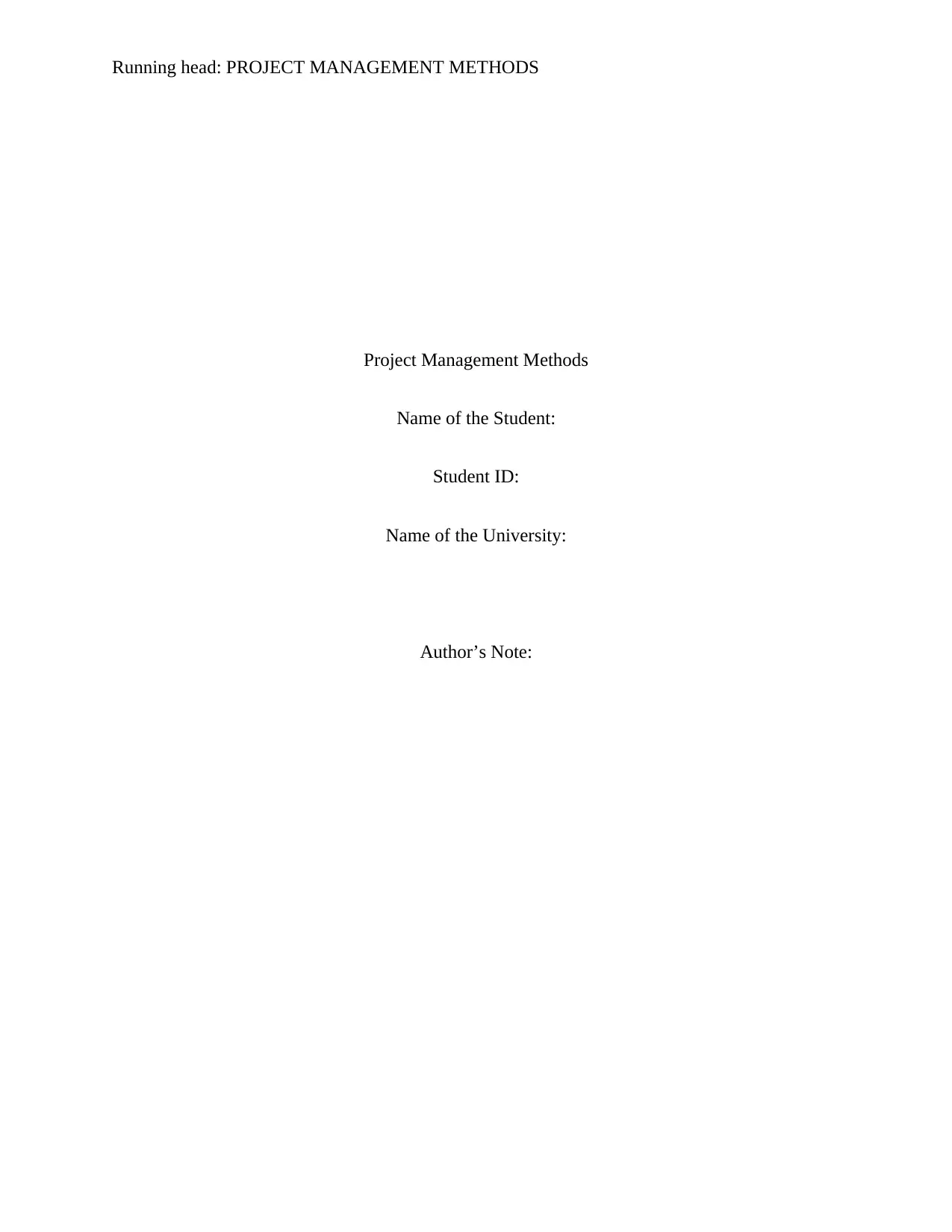
Running head: PROJECT MANAGEMENT METHODS
Project Management Methods
Name of the Student:
Student ID:
Name of the University:
Author’s Note:
Project Management Methods
Name of the Student:
Student ID:
Name of the University:
Author’s Note:
Secure Best Marks with AI Grader
Need help grading? Try our AI Grader for instant feedback on your assignments.
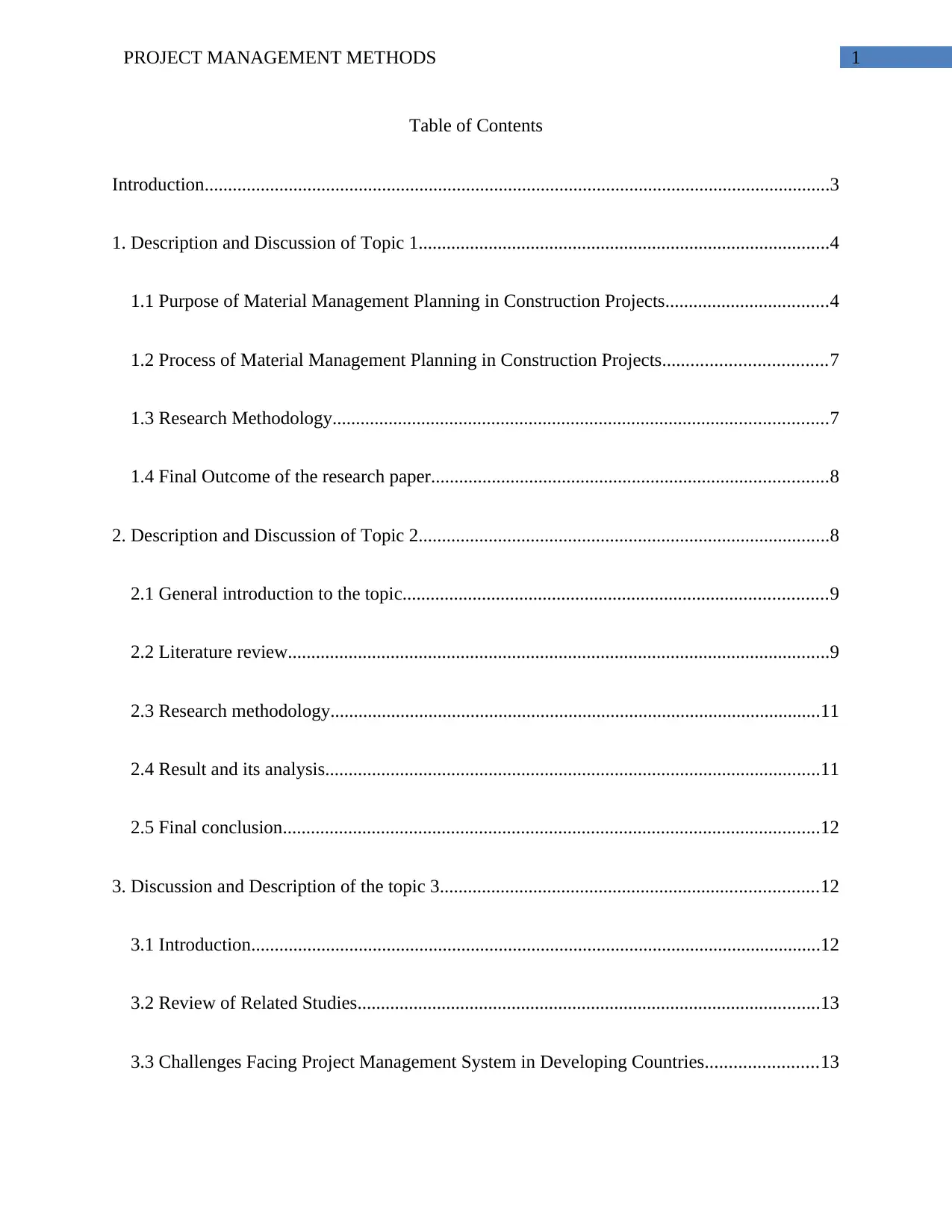
1PROJECT MANAGEMENT METHODS
Table of Contents
Introduction......................................................................................................................................3
1. Description and Discussion of Topic 1........................................................................................4
1.1 Purpose of Material Management Planning in Construction Projects...................................4
1.2 Process of Material Management Planning in Construction Projects...................................7
1.3 Research Methodology..........................................................................................................7
1.4 Final Outcome of the research paper.....................................................................................8
2. Description and Discussion of Topic 2........................................................................................8
2.1 General introduction to the topic...........................................................................................9
2.2 Literature review....................................................................................................................9
2.3 Research methodology.........................................................................................................11
2.4 Result and its analysis..........................................................................................................11
2.5 Final conclusion...................................................................................................................12
3. Discussion and Description of the topic 3.................................................................................12
3.1 Introduction..........................................................................................................................12
3.2 Review of Related Studies...................................................................................................13
3.3 Challenges Facing Project Management System in Developing Countries........................13
Table of Contents
Introduction......................................................................................................................................3
1. Description and Discussion of Topic 1........................................................................................4
1.1 Purpose of Material Management Planning in Construction Projects...................................4
1.2 Process of Material Management Planning in Construction Projects...................................7
1.3 Research Methodology..........................................................................................................7
1.4 Final Outcome of the research paper.....................................................................................8
2. Description and Discussion of Topic 2........................................................................................8
2.1 General introduction to the topic...........................................................................................9
2.2 Literature review....................................................................................................................9
2.3 Research methodology.........................................................................................................11
2.4 Result and its analysis..........................................................................................................11
2.5 Final conclusion...................................................................................................................12
3. Discussion and Description of the topic 3.................................................................................12
3.1 Introduction..........................................................................................................................12
3.2 Review of Related Studies...................................................................................................13
3.3 Challenges Facing Project Management System in Developing Countries........................13
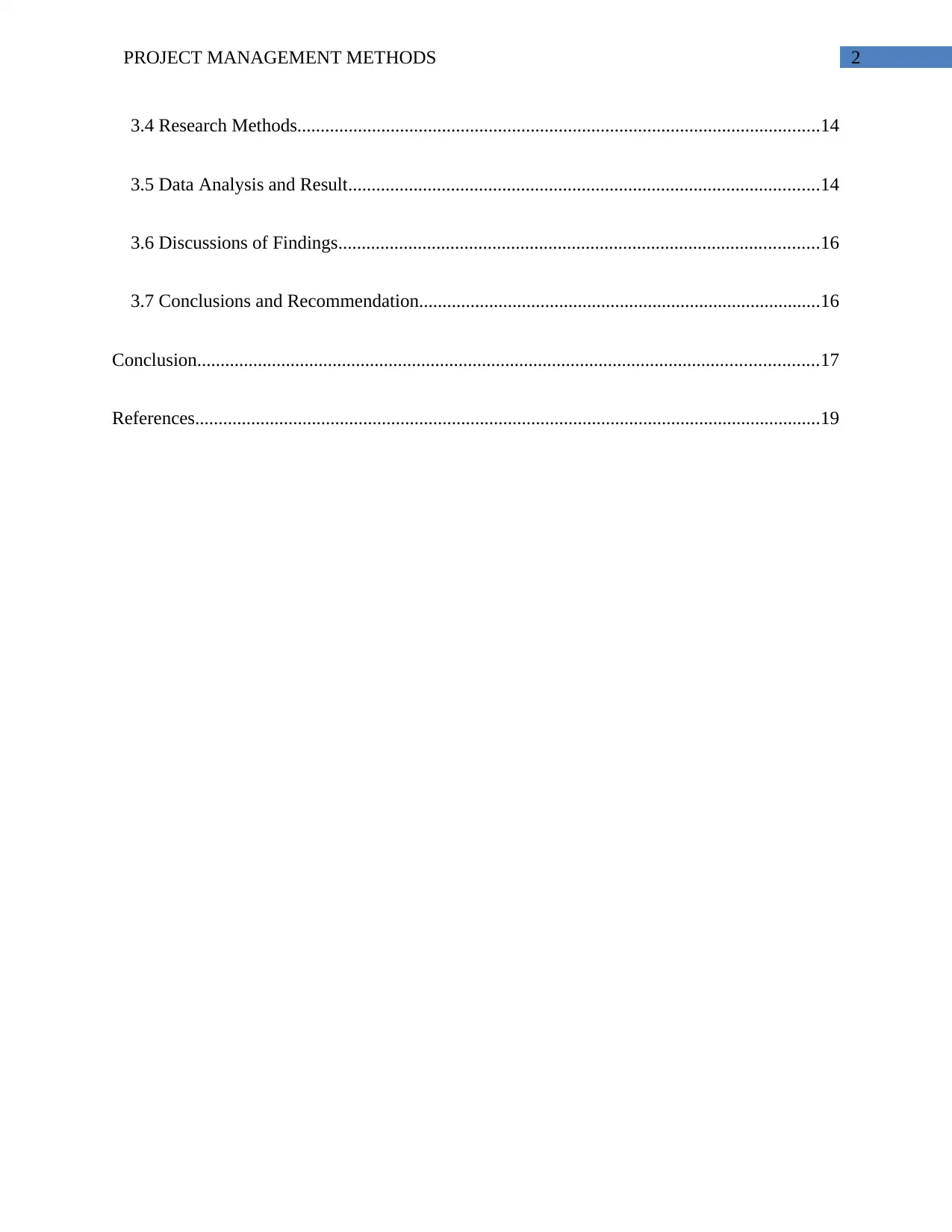
2PROJECT MANAGEMENT METHODS
3.4 Research Methods................................................................................................................14
3.5 Data Analysis and Result.....................................................................................................14
3.6 Discussions of Findings.......................................................................................................16
3.7 Conclusions and Recommendation......................................................................................16
Conclusion.....................................................................................................................................17
References......................................................................................................................................19
3.4 Research Methods................................................................................................................14
3.5 Data Analysis and Result.....................................................................................................14
3.6 Discussions of Findings.......................................................................................................16
3.7 Conclusions and Recommendation......................................................................................16
Conclusion.....................................................................................................................................17
References......................................................................................................................................19
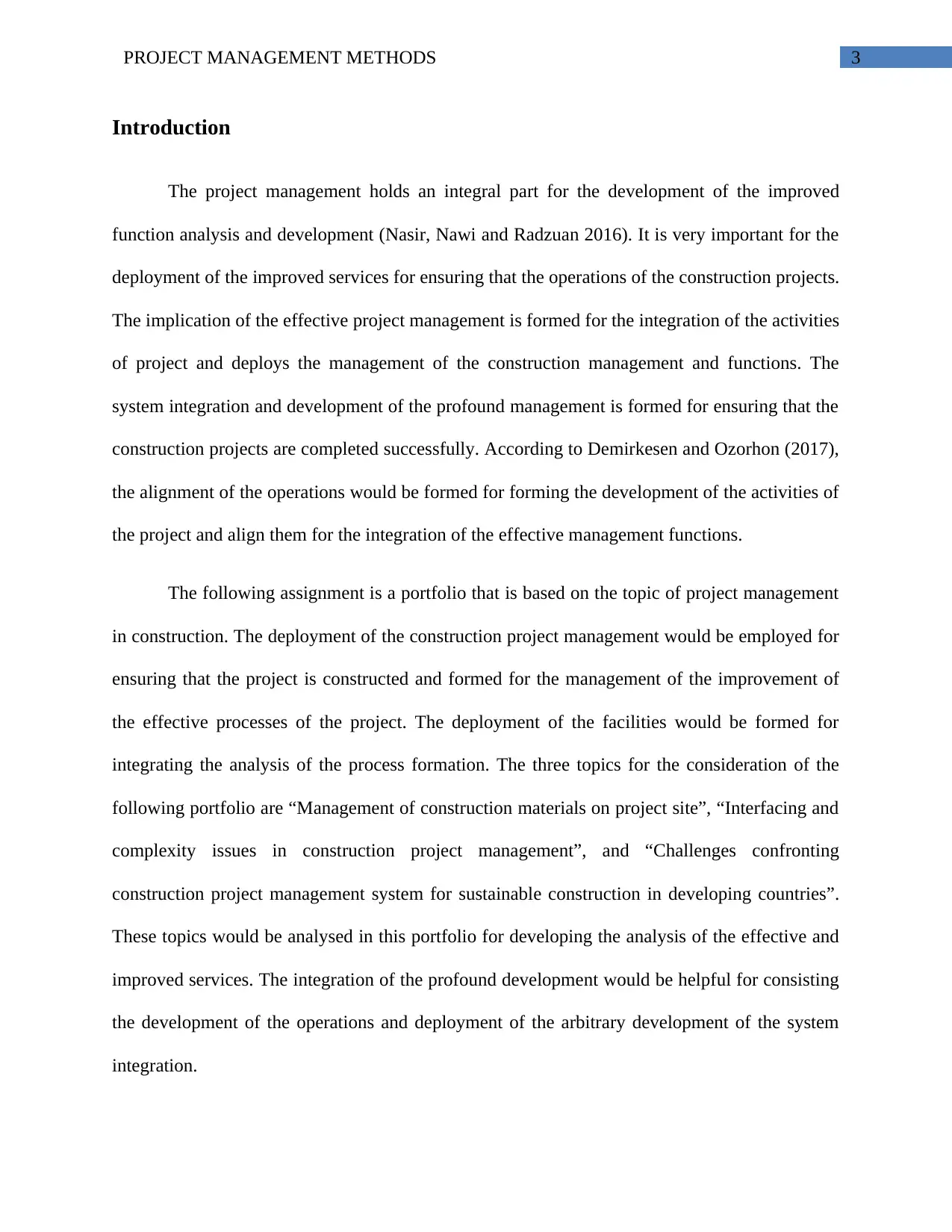
3PROJECT MANAGEMENT METHODS
Introduction
The project management holds an integral part for the development of the improved
function analysis and development (Nasir, Nawi and Radzuan 2016). It is very important for the
deployment of the improved services for ensuring that the operations of the construction projects.
The implication of the effective project management is formed for the integration of the activities
of project and deploys the management of the construction management and functions. The
system integration and development of the profound management is formed for ensuring that the
construction projects are completed successfully. According to Demirkesen and Ozorhon (2017),
the alignment of the operations would be formed for forming the development of the activities of
the project and align them for the integration of the effective management functions.
The following assignment is a portfolio that is based on the topic of project management
in construction. The deployment of the construction project management would be employed for
ensuring that the project is constructed and formed for the management of the improvement of
the effective processes of the project. The deployment of the facilities would be formed for
integrating the analysis of the process formation. The three topics for the consideration of the
following portfolio are “Management of construction materials on project site”, “Interfacing and
complexity issues in construction project management”, and “Challenges confronting
construction project management system for sustainable construction in developing countries”.
These topics would be analysed in this portfolio for developing the analysis of the effective and
improved services. The integration of the profound development would be helpful for consisting
the development of the operations and deployment of the arbitrary development of the system
integration.
Introduction
The project management holds an integral part for the development of the improved
function analysis and development (Nasir, Nawi and Radzuan 2016). It is very important for the
deployment of the improved services for ensuring that the operations of the construction projects.
The implication of the effective project management is formed for the integration of the activities
of project and deploys the management of the construction management and functions. The
system integration and development of the profound management is formed for ensuring that the
construction projects are completed successfully. According to Demirkesen and Ozorhon (2017),
the alignment of the operations would be formed for forming the development of the activities of
the project and align them for the integration of the effective management functions.
The following assignment is a portfolio that is based on the topic of project management
in construction. The deployment of the construction project management would be employed for
ensuring that the project is constructed and formed for the management of the improvement of
the effective processes of the project. The deployment of the facilities would be formed for
integrating the analysis of the process formation. The three topics for the consideration of the
following portfolio are “Management of construction materials on project site”, “Interfacing and
complexity issues in construction project management”, and “Challenges confronting
construction project management system for sustainable construction in developing countries”.
These topics would be analysed in this portfolio for developing the analysis of the effective and
improved services. The integration of the profound development would be helpful for consisting
the development of the operations and deployment of the arbitrary development of the system
integration.
Paraphrase This Document
Need a fresh take? Get an instant paraphrase of this document with our AI Paraphraser
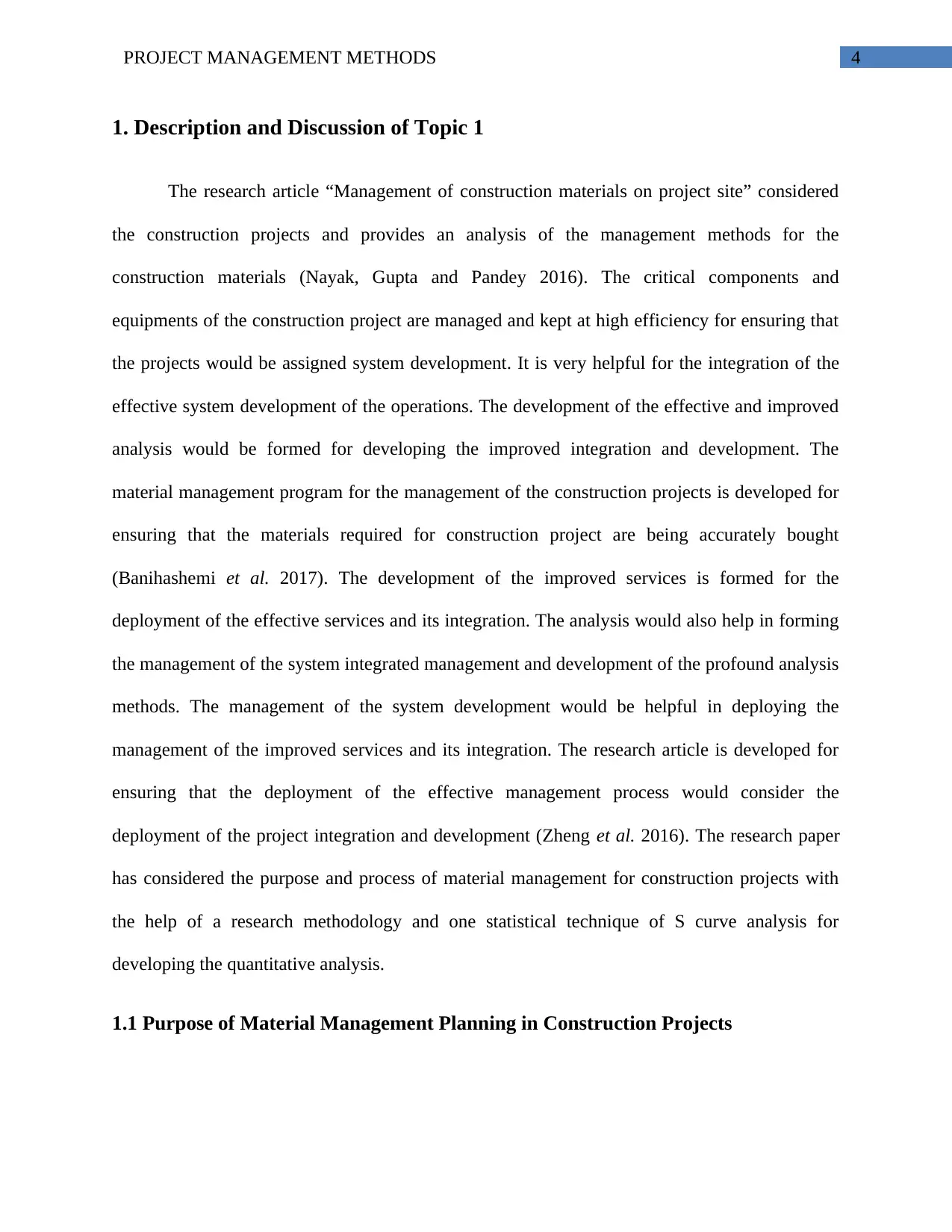
4PROJECT MANAGEMENT METHODS
1. Description and Discussion of Topic 1
The research article “Management of construction materials on project site” considered
the construction projects and provides an analysis of the management methods for the
construction materials (Nayak, Gupta and Pandey 2016). The critical components and
equipments of the construction project are managed and kept at high efficiency for ensuring that
the projects would be assigned system development. It is very helpful for the integration of the
effective system development of the operations. The development of the effective and improved
analysis would be formed for developing the improved integration and development. The
material management program for the management of the construction projects is developed for
ensuring that the materials required for construction project are being accurately bought
(Banihashemi et al. 2017). The development of the improved services is formed for the
deployment of the effective services and its integration. The analysis would also help in forming
the management of the system integrated management and development of the profound analysis
methods. The management of the system development would be helpful in deploying the
management of the improved services and its integration. The research article is developed for
ensuring that the deployment of the effective management process would consider the
deployment of the project integration and development (Zheng et al. 2016). The research paper
has considered the purpose and process of material management for construction projects with
the help of a research methodology and one statistical technique of S curve analysis for
developing the quantitative analysis.
1.1 Purpose of Material Management Planning in Construction Projects
1. Description and Discussion of Topic 1
The research article “Management of construction materials on project site” considered
the construction projects and provides an analysis of the management methods for the
construction materials (Nayak, Gupta and Pandey 2016). The critical components and
equipments of the construction project are managed and kept at high efficiency for ensuring that
the projects would be assigned system development. It is very helpful for the integration of the
effective system development of the operations. The development of the effective and improved
analysis would be formed for developing the improved integration and development. The
material management program for the management of the construction projects is developed for
ensuring that the materials required for construction project are being accurately bought
(Banihashemi et al. 2017). The development of the improved services is formed for the
deployment of the effective services and its integration. The analysis would also help in forming
the management of the system integrated management and development of the profound analysis
methods. The management of the system development would be helpful in deploying the
management of the improved services and its integration. The research article is developed for
ensuring that the deployment of the effective management process would consider the
deployment of the project integration and development (Zheng et al. 2016). The research paper
has considered the purpose and process of material management for construction projects with
the help of a research methodology and one statistical technique of S curve analysis for
developing the quantitative analysis.
1.1 Purpose of Material Management Planning in Construction Projects
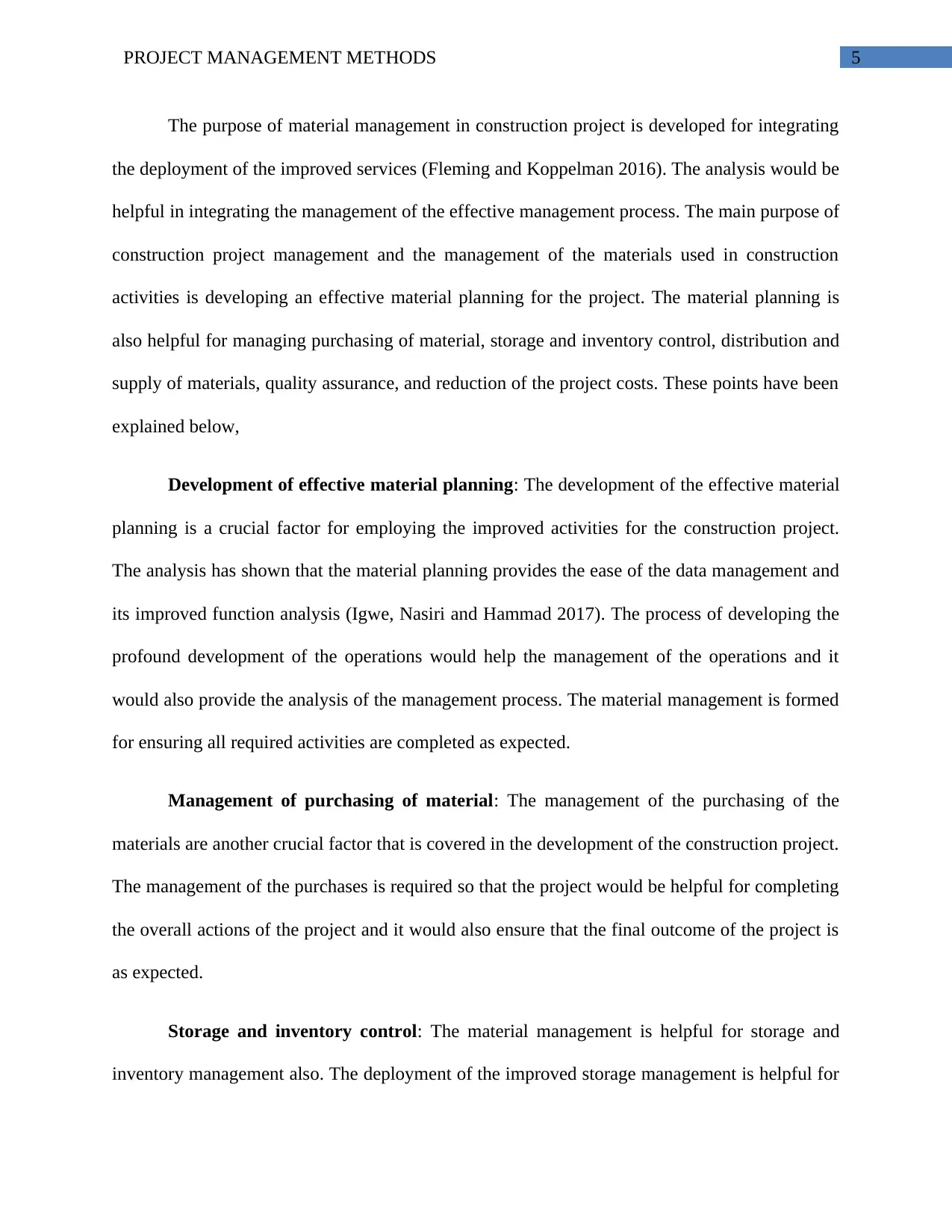
5PROJECT MANAGEMENT METHODS
The purpose of material management in construction project is developed for integrating
the deployment of the improved services (Fleming and Koppelman 2016). The analysis would be
helpful in integrating the management of the effective management process. The main purpose of
construction project management and the management of the materials used in construction
activities is developing an effective material planning for the project. The material planning is
also helpful for managing purchasing of material, storage and inventory control, distribution and
supply of materials, quality assurance, and reduction of the project costs. These points have been
explained below,
Development of effective material planning: The development of the effective material
planning is a crucial factor for employing the improved activities for the construction project.
The analysis has shown that the material planning provides the ease of the data management and
its improved function analysis (Igwe, Nasiri and Hammad 2017). The process of developing the
profound development of the operations would help the management of the operations and it
would also provide the analysis of the management process. The material management is formed
for ensuring all required activities are completed as expected.
Management of purchasing of material: The management of the purchasing of the
materials are another crucial factor that is covered in the development of the construction project.
The management of the purchases is required so that the project would be helpful for completing
the overall actions of the project and it would also ensure that the final outcome of the project is
as expected.
Storage and inventory control: The material management is helpful for storage and
inventory management also. The deployment of the improved storage management is helpful for
The purpose of material management in construction project is developed for integrating
the deployment of the improved services (Fleming and Koppelman 2016). The analysis would be
helpful in integrating the management of the effective management process. The main purpose of
construction project management and the management of the materials used in construction
activities is developing an effective material planning for the project. The material planning is
also helpful for managing purchasing of material, storage and inventory control, distribution and
supply of materials, quality assurance, and reduction of the project costs. These points have been
explained below,
Development of effective material planning: The development of the effective material
planning is a crucial factor for employing the improved activities for the construction project.
The analysis has shown that the material planning provides the ease of the data management and
its improved function analysis (Igwe, Nasiri and Hammad 2017). The process of developing the
profound development of the operations would help the management of the operations and it
would also provide the analysis of the management process. The material management is formed
for ensuring all required activities are completed as expected.
Management of purchasing of material: The management of the purchasing of the
materials are another crucial factor that is covered in the development of the construction project.
The management of the purchases is required so that the project would be helpful for completing
the overall actions of the project and it would also ensure that the final outcome of the project is
as expected.
Storage and inventory control: The material management is helpful for storage and
inventory management also. The deployment of the improved storage management is helpful for
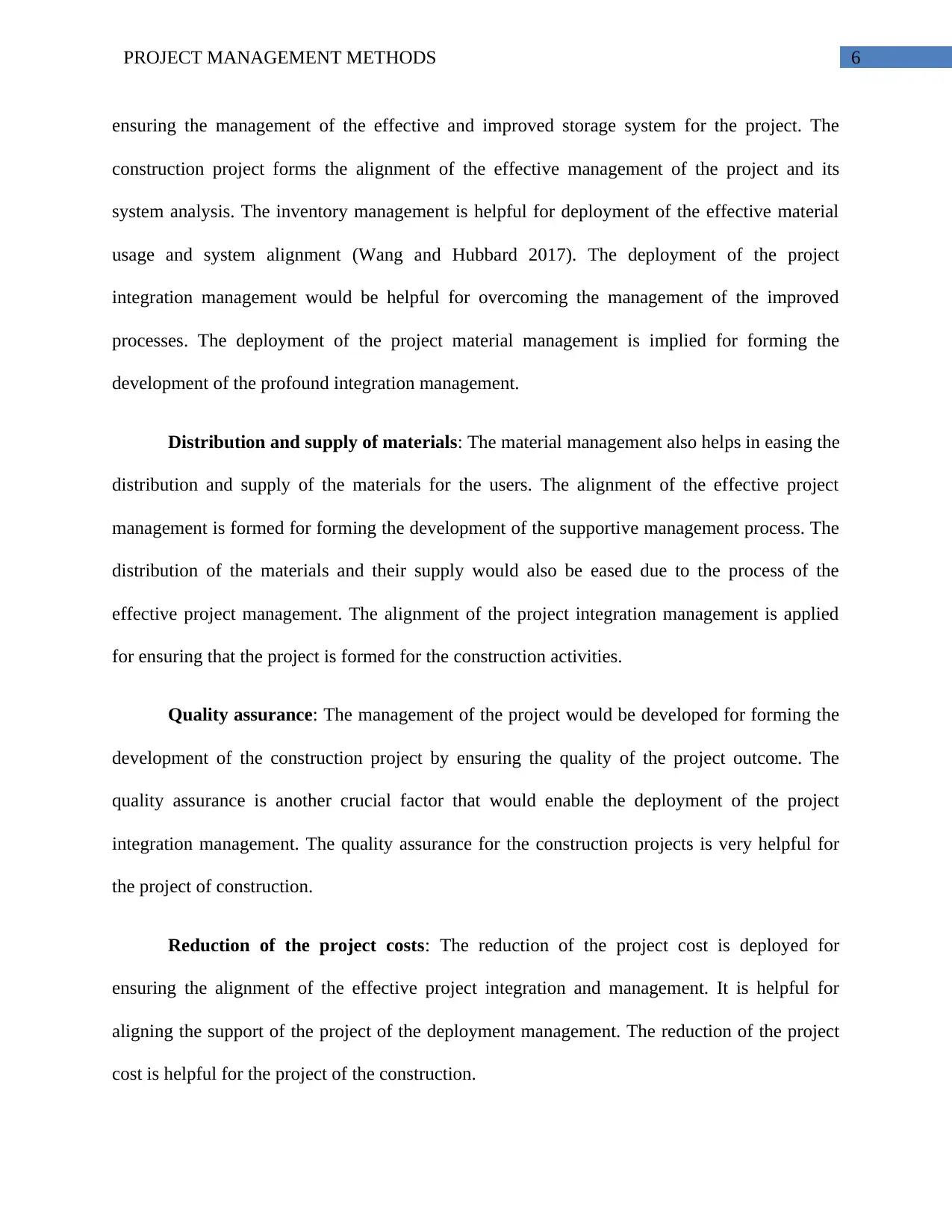
6PROJECT MANAGEMENT METHODS
ensuring the management of the effective and improved storage system for the project. The
construction project forms the alignment of the effective management of the project and its
system analysis. The inventory management is helpful for deployment of the effective material
usage and system alignment (Wang and Hubbard 2017). The deployment of the project
integration management would be helpful for overcoming the management of the improved
processes. The deployment of the project material management is implied for forming the
development of the profound integration management.
Distribution and supply of materials: The material management also helps in easing the
distribution and supply of the materials for the users. The alignment of the effective project
management is formed for forming the development of the supportive management process. The
distribution of the materials and their supply would also be eased due to the process of the
effective project management. The alignment of the project integration management is applied
for ensuring that the project is formed for the construction activities.
Quality assurance: The management of the project would be developed for forming the
development of the construction project by ensuring the quality of the project outcome. The
quality assurance is another crucial factor that would enable the deployment of the project
integration management. The quality assurance for the construction projects is very helpful for
the project of construction.
Reduction of the project costs: The reduction of the project cost is deployed for
ensuring the alignment of the effective project integration and management. It is helpful for
aligning the support of the project of the deployment management. The reduction of the project
cost is helpful for the project of the construction.
ensuring the management of the effective and improved storage system for the project. The
construction project forms the alignment of the effective management of the project and its
system analysis. The inventory management is helpful for deployment of the effective material
usage and system alignment (Wang and Hubbard 2017). The deployment of the project
integration management would be helpful for overcoming the management of the improved
processes. The deployment of the project material management is implied for forming the
development of the profound integration management.
Distribution and supply of materials: The material management also helps in easing the
distribution and supply of the materials for the users. The alignment of the effective project
management is formed for forming the development of the supportive management process. The
distribution of the materials and their supply would also be eased due to the process of the
effective project management. The alignment of the project integration management is applied
for ensuring that the project is formed for the construction activities.
Quality assurance: The management of the project would be developed for forming the
development of the construction project by ensuring the quality of the project outcome. The
quality assurance is another crucial factor that would enable the deployment of the project
integration management. The quality assurance for the construction projects is very helpful for
the project of construction.
Reduction of the project costs: The reduction of the project cost is deployed for
ensuring the alignment of the effective project integration and management. It is helpful for
aligning the support of the project of the deployment management. The reduction of the project
cost is helpful for the project of the construction.
Secure Best Marks with AI Grader
Need help grading? Try our AI Grader for instant feedback on your assignments.
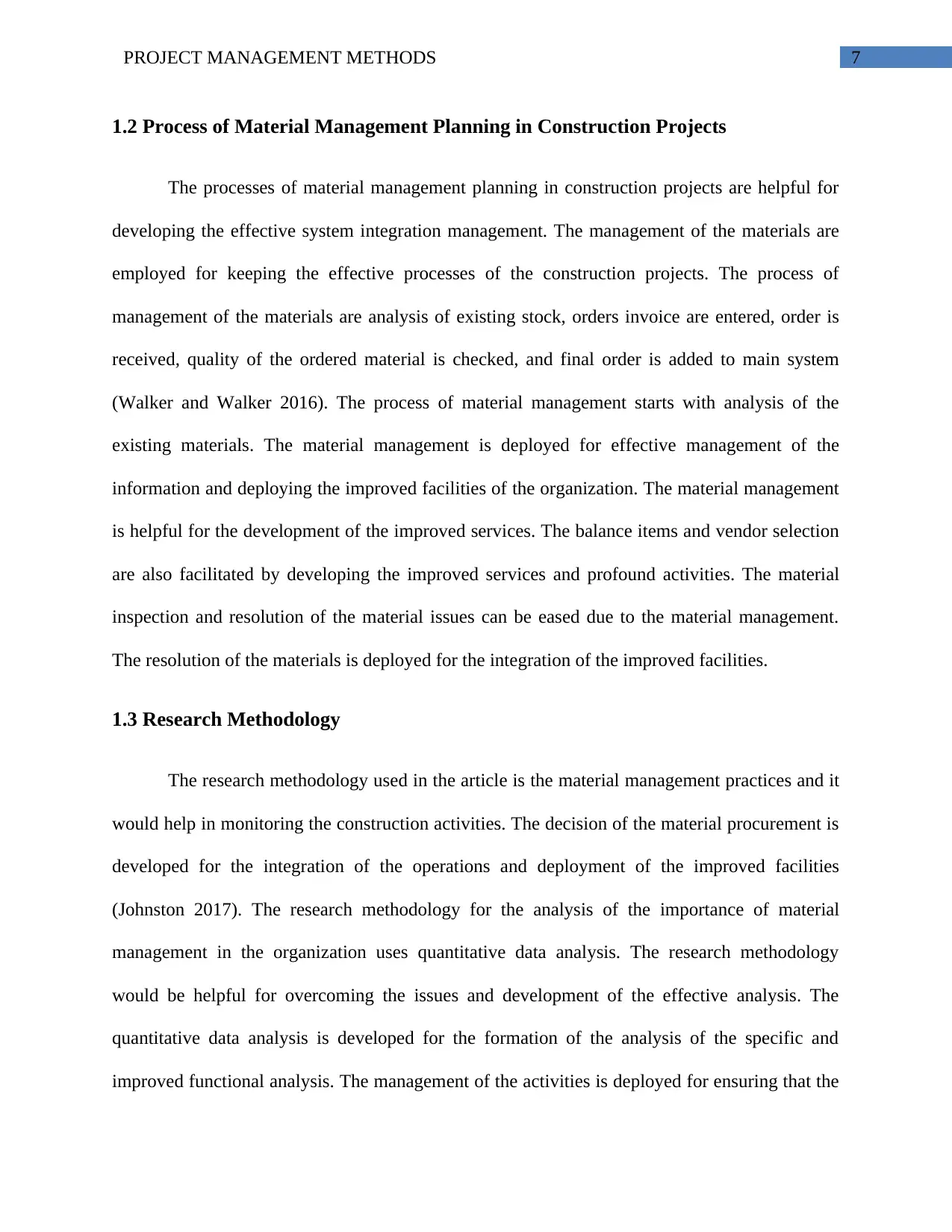
7PROJECT MANAGEMENT METHODS
1.2 Process of Material Management Planning in Construction Projects
The processes of material management planning in construction projects are helpful for
developing the effective system integration management. The management of the materials are
employed for keeping the effective processes of the construction projects. The process of
management of the materials are analysis of existing stock, orders invoice are entered, order is
received, quality of the ordered material is checked, and final order is added to main system
(Walker and Walker 2016). The process of material management starts with analysis of the
existing materials. The material management is deployed for effective management of the
information and deploying the improved facilities of the organization. The material management
is helpful for the development of the improved services. The balance items and vendor selection
are also facilitated by developing the improved services and profound activities. The material
inspection and resolution of the material issues can be eased due to the material management.
The resolution of the materials is deployed for the integration of the improved facilities.
1.3 Research Methodology
The research methodology used in the article is the material management practices and it
would help in monitoring the construction activities. The decision of the material procurement is
developed for the integration of the operations and deployment of the improved facilities
(Johnston 2017). The research methodology for the analysis of the importance of material
management in the organization uses quantitative data analysis. The research methodology
would be helpful for overcoming the issues and development of the effective analysis. The
quantitative data analysis is developed for the formation of the analysis of the specific and
improved functional analysis. The management of the activities is deployed for ensuring that the
1.2 Process of Material Management Planning in Construction Projects
The processes of material management planning in construction projects are helpful for
developing the effective system integration management. The management of the materials are
employed for keeping the effective processes of the construction projects. The process of
management of the materials are analysis of existing stock, orders invoice are entered, order is
received, quality of the ordered material is checked, and final order is added to main system
(Walker and Walker 2016). The process of material management starts with analysis of the
existing materials. The material management is deployed for effective management of the
information and deploying the improved facilities of the organization. The material management
is helpful for the development of the improved services. The balance items and vendor selection
are also facilitated by developing the improved services and profound activities. The material
inspection and resolution of the material issues can be eased due to the material management.
The resolution of the materials is deployed for the integration of the improved facilities.
1.3 Research Methodology
The research methodology used in the article is the material management practices and it
would help in monitoring the construction activities. The decision of the material procurement is
developed for the integration of the operations and deployment of the improved facilities
(Johnston 2017). The research methodology for the analysis of the importance of material
management in the organization uses quantitative data analysis. The research methodology
would be helpful for overcoming the issues and development of the effective analysis. The
quantitative data analysis is developed for the formation of the analysis of the specific and
improved functional analysis. The management of the activities is deployed for ensuring that the

8PROJECT MANAGEMENT METHODS
specific and successive development of the operations is formed for the system integration and
development. The management scheme for the materials is developed for overcoming the gap in
the study of the research topic. The quantitative study is formed with the help of ABC and EOQ
analysis. The technique of ABC analysis consists of the principle that the small part of the items
can show a bulk of monetary value. The A category represents 70-75% of the money value, the
B category represents 15-20% of the money value, and C category represents the 5-10% of the
money value. The economic order quantity or EOQ would result in analysing the specific item’s
costs and the total number of orders of least value (Woodgate, Zurba and Tennent 2016). The
research paper also deals with the use of S-curve analysis for showing the relation between the
actual and planned costs of the materials.
1.4 Final Outcome of the research paper
The data gathered and the analysis of the available data has shown that the S-curve and
EOQ analysis would be helpful for deducing the specific and profound RCC design of the data
would tend to show that the construction project would require the use of the material
management for the completion of the project. The specification has shown that the deviation in
items would result in forming the fluctuations in the cost of the specific cost estimation. The
material management is helpful for construction project to quote accurate values in the tender
and then ensure that the overall quote of the costs does not exceed than the expectations.
2. Description and Discussion of Topic 2
The journal article is titled “Interfacing and Complexity Issues in Project Management: A
Case Study of a Condominium Construction Project in Klang Valley” and it provides an analysis
of the complexity and interface issues that major construction projects face. The reason of
specific and successive development of the operations is formed for the system integration and
development. The management scheme for the materials is developed for overcoming the gap in
the study of the research topic. The quantitative study is formed with the help of ABC and EOQ
analysis. The technique of ABC analysis consists of the principle that the small part of the items
can show a bulk of monetary value. The A category represents 70-75% of the money value, the
B category represents 15-20% of the money value, and C category represents the 5-10% of the
money value. The economic order quantity or EOQ would result in analysing the specific item’s
costs and the total number of orders of least value (Woodgate, Zurba and Tennent 2016). The
research paper also deals with the use of S-curve analysis for showing the relation between the
actual and planned costs of the materials.
1.4 Final Outcome of the research paper
The data gathered and the analysis of the available data has shown that the S-curve and
EOQ analysis would be helpful for deducing the specific and profound RCC design of the data
would tend to show that the construction project would require the use of the material
management for the completion of the project. The specification has shown that the deviation in
items would result in forming the fluctuations in the cost of the specific cost estimation. The
material management is helpful for construction project to quote accurate values in the tender
and then ensure that the overall quote of the costs does not exceed than the expectations.
2. Description and Discussion of Topic 2
The journal article is titled “Interfacing and Complexity Issues in Project Management: A
Case Study of a Condominium Construction Project in Klang Valley” and it provides an analysis
of the complexity and interface issues that major construction projects face. The reason of

9PROJECT MANAGEMENT METHODS
project failure is always argued to be either human or the materials. According to Tan (2016), the
above research analyse two factors namely complexity and interfaces that would result in the
generation of the issues in project management. The paper consists of a general introduction to
the topic, literature review section, research methodology, result and its analysis, and final
conclusion.
2.1 General introduction to the topic
The first part of the research paper provides the analysis of the various reasons of the
project failure. The present world is well aware of the fact that out of 6927 construction projects
worth RM 131 billion was kicked off due to some issues (Nicholas and Steyn 2017). The use of
the technological development has been largely used for ensuring that the projects are completed
successfully. However, due to the use of the technological equipments, the probability of the
occurrence of the issues has increased too. The analysis would show that the development of the
issues and the use of the equipments had been simultaneously increasing. The statistics have
shown that only 39% of the overall construction projects have been successful in terms of
budget, time, and quality. The remaining 61% of the projects have failed due to cost overrun,
delay, and other features (Erdogan, Saparauskas and Turskis 2017). The project is cancelled due
to the unpredictable and profound issues in the project. The projects that had headed to failure in
terms of budget, time or quality are due to the internal issues. Very few of the project team
members or client want to talk about the reasons for the failure of the project and do not admit
even if it is their fault.
2.2 Literature review
project failure is always argued to be either human or the materials. According to Tan (2016), the
above research analyse two factors namely complexity and interfaces that would result in the
generation of the issues in project management. The paper consists of a general introduction to
the topic, literature review section, research methodology, result and its analysis, and final
conclusion.
2.1 General introduction to the topic
The first part of the research paper provides the analysis of the various reasons of the
project failure. The present world is well aware of the fact that out of 6927 construction projects
worth RM 131 billion was kicked off due to some issues (Nicholas and Steyn 2017). The use of
the technological development has been largely used for ensuring that the projects are completed
successfully. However, due to the use of the technological equipments, the probability of the
occurrence of the issues has increased too. The analysis would show that the development of the
issues and the use of the equipments had been simultaneously increasing. The statistics have
shown that only 39% of the overall construction projects have been successful in terms of
budget, time, and quality. The remaining 61% of the projects have failed due to cost overrun,
delay, and other features (Erdogan, Saparauskas and Turskis 2017). The project is cancelled due
to the unpredictable and profound issues in the project. The projects that had headed to failure in
terms of budget, time or quality are due to the internal issues. Very few of the project team
members or client want to talk about the reasons for the failure of the project and do not admit
even if it is their fault.
2.2 Literature review
Paraphrase This Document
Need a fresh take? Get an instant paraphrase of this document with our AI Paraphraser
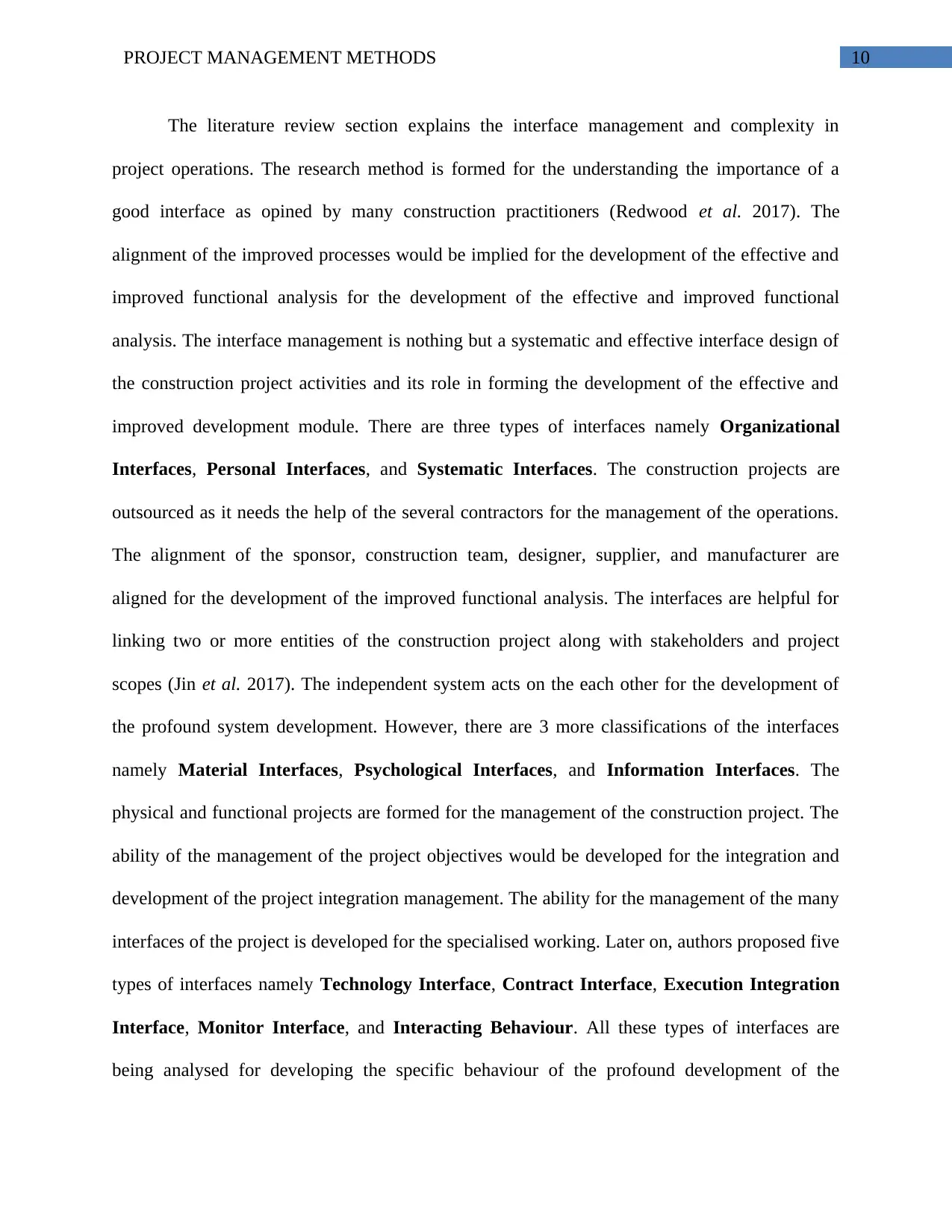
10PROJECT MANAGEMENT METHODS
The literature review section explains the interface management and complexity in
project operations. The research method is formed for the understanding the importance of a
good interface as opined by many construction practitioners (Redwood et al. 2017). The
alignment of the improved processes would be implied for the development of the effective and
improved functional analysis for the development of the effective and improved functional
analysis. The interface management is nothing but a systematic and effective interface design of
the construction project activities and its role in forming the development of the effective and
improved development module. There are three types of interfaces namely Organizational
Interfaces, Personal Interfaces, and Systematic Interfaces. The construction projects are
outsourced as it needs the help of the several contractors for the management of the operations.
The alignment of the sponsor, construction team, designer, supplier, and manufacturer are
aligned for the development of the improved functional analysis. The interfaces are helpful for
linking two or more entities of the construction project along with stakeholders and project
scopes (Jin et al. 2017). The independent system acts on the each other for the development of
the profound system development. However, there are 3 more classifications of the interfaces
namely Material Interfaces, Psychological Interfaces, and Information Interfaces. The
physical and functional projects are formed for the management of the construction project. The
ability of the management of the project objectives would be developed for the integration and
development of the project integration management. The ability for the management of the many
interfaces of the project is developed for the specialised working. Later on, authors proposed five
types of interfaces namely Technology Interface, Contract Interface, Execution Integration
Interface, Monitor Interface, and Interacting Behaviour. All these types of interfaces are
being analysed for developing the specific behaviour of the profound development of the
The literature review section explains the interface management and complexity in
project operations. The research method is formed for the understanding the importance of a
good interface as opined by many construction practitioners (Redwood et al. 2017). The
alignment of the improved processes would be implied for the development of the effective and
improved functional analysis for the development of the effective and improved functional
analysis. The interface management is nothing but a systematic and effective interface design of
the construction project activities and its role in forming the development of the effective and
improved development module. There are three types of interfaces namely Organizational
Interfaces, Personal Interfaces, and Systematic Interfaces. The construction projects are
outsourced as it needs the help of the several contractors for the management of the operations.
The alignment of the sponsor, construction team, designer, supplier, and manufacturer are
aligned for the development of the improved functional analysis. The interfaces are helpful for
linking two or more entities of the construction project along with stakeholders and project
scopes (Jin et al. 2017). The independent system acts on the each other for the development of
the profound system development. However, there are 3 more classifications of the interfaces
namely Material Interfaces, Psychological Interfaces, and Information Interfaces. The
physical and functional projects are formed for the management of the construction project. The
ability of the management of the project objectives would be developed for the integration and
development of the project integration management. The ability for the management of the many
interfaces of the project is developed for the specialised working. Later on, authors proposed five
types of interfaces namely Technology Interface, Contract Interface, Execution Integration
Interface, Monitor Interface, and Interacting Behaviour. All these types of interfaces are
being analysed for developing the specific behaviour of the profound development of the
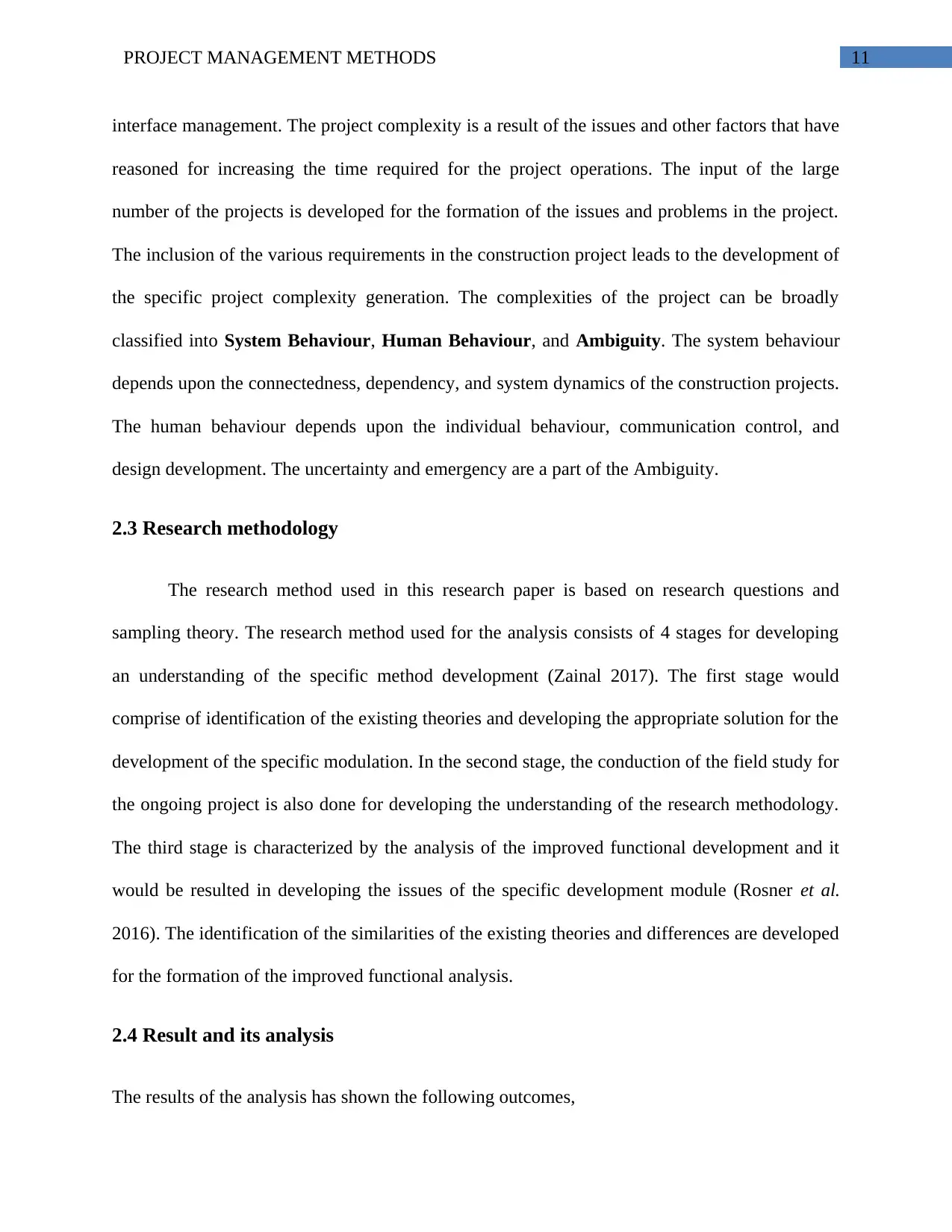
11PROJECT MANAGEMENT METHODS
interface management. The project complexity is a result of the issues and other factors that have
reasoned for increasing the time required for the project operations. The input of the large
number of the projects is developed for the formation of the issues and problems in the project.
The inclusion of the various requirements in the construction project leads to the development of
the specific project complexity generation. The complexities of the project can be broadly
classified into System Behaviour, Human Behaviour, and Ambiguity. The system behaviour
depends upon the connectedness, dependency, and system dynamics of the construction projects.
The human behaviour depends upon the individual behaviour, communication control, and
design development. The uncertainty and emergency are a part of the Ambiguity.
2.3 Research methodology
The research method used in this research paper is based on research questions and
sampling theory. The research method used for the analysis consists of 4 stages for developing
an understanding of the specific method development (Zainal 2017). The first stage would
comprise of identification of the existing theories and developing the appropriate solution for the
development of the specific modulation. In the second stage, the conduction of the field study for
the ongoing project is also done for developing the understanding of the research methodology.
The third stage is characterized by the analysis of the improved functional development and it
would be resulted in developing the issues of the specific development module (Rosner et al.
2016). The identification of the similarities of the existing theories and differences are developed
for the formation of the improved functional analysis.
2.4 Result and its analysis
The results of the analysis has shown the following outcomes,
interface management. The project complexity is a result of the issues and other factors that have
reasoned for increasing the time required for the project operations. The input of the large
number of the projects is developed for the formation of the issues and problems in the project.
The inclusion of the various requirements in the construction project leads to the development of
the specific project complexity generation. The complexities of the project can be broadly
classified into System Behaviour, Human Behaviour, and Ambiguity. The system behaviour
depends upon the connectedness, dependency, and system dynamics of the construction projects.
The human behaviour depends upon the individual behaviour, communication control, and
design development. The uncertainty and emergency are a part of the Ambiguity.
2.3 Research methodology
The research method used in this research paper is based on research questions and
sampling theory. The research method used for the analysis consists of 4 stages for developing
an understanding of the specific method development (Zainal 2017). The first stage would
comprise of identification of the existing theories and developing the appropriate solution for the
development of the specific modulation. In the second stage, the conduction of the field study for
the ongoing project is also done for developing the understanding of the research methodology.
The third stage is characterized by the analysis of the improved functional development and it
would be resulted in developing the issues of the specific development module (Rosner et al.
2016). The identification of the similarities of the existing theories and differences are developed
for the formation of the improved functional analysis.
2.4 Result and its analysis
The results of the analysis has shown the following outcomes,

12PROJECT MANAGEMENT METHODS
Communication problem is the primary reason that has resulted in forming the issues in
the interface of the project and growth of the complexities.
The drawings and its submission have resulted in forming the connection between the
main contractor and sub-contractor.
The approval of the design and changes is another factor that should be used for dealing
with the issues of the project
2.5 Final conclusion
The various issues of the construction projects are issues in interfaces and growth of the
complexities. The difference in the onsite and offsite teams has resulted in forming the specific
issues in the completion of the project. The client, consultants, and main contractors have to form
a subtle communication for ensuring the completion of the project as expected.
3. Discussion and Description of the topic 3
3.1 Introduction
The process of building up a dwelling place for humans has been in the constant evolving
phase since the early days of mankind. The procedure for building a dwelling can be grouped
into three major phases, the design phase, construction phase and the operational use phase. The
management of projects can be said to be one of the oldest form of accomplishments for the
mankind which makes use of builders, masons, architects and crafts men (Ogunde et al. 2017).
Due to the high demand of construction practice, a higher demand for the management of the
process with the use of adequate amount of planning and use of resources is essential. The
Communication problem is the primary reason that has resulted in forming the issues in
the interface of the project and growth of the complexities.
The drawings and its submission have resulted in forming the connection between the
main contractor and sub-contractor.
The approval of the design and changes is another factor that should be used for dealing
with the issues of the project
2.5 Final conclusion
The various issues of the construction projects are issues in interfaces and growth of the
complexities. The difference in the onsite and offsite teams has resulted in forming the specific
issues in the completion of the project. The client, consultants, and main contractors have to form
a subtle communication for ensuring the completion of the project as expected.
3. Discussion and Description of the topic 3
3.1 Introduction
The process of building up a dwelling place for humans has been in the constant evolving
phase since the early days of mankind. The procedure for building a dwelling can be grouped
into three major phases, the design phase, construction phase and the operational use phase. The
management of projects can be said to be one of the oldest form of accomplishments for the
mankind which makes use of builders, masons, architects and crafts men (Ogunde et al. 2017).
Due to the high demand of construction practice, a higher demand for the management of the
process with the use of adequate amount of planning and use of resources is essential. The
Secure Best Marks with AI Grader
Need help grading? Try our AI Grader for instant feedback on your assignments.

13PROJECT MANAGEMENT METHODS
Nigerian Construction Sector Summary Report 2010 – 2012 attributed the continuous growth to
the dynamisms of development.
3.2 Review of Related Studies
Researchers of the topic of project management have said that the meaning of project and
management can be defined separately. Project work can be said to be a temporary endeavor for
the work on a certain project with a continuous evolving procedure. The activities related to the
project management can be said to be of four distinct life cycle process: Conceptualization,
Planning, Execution, and Termination. The building and construction sector is an important
contributor to Nigeria’s GDP (Banihashemi et al. 2017). It has been found that the Nigerian
building and construction sector is significantly growing.
3.3 Challenges Facing Project Management System in Developing Countries
The process of project management has certain limitation in the form of high cost
overrun, time delay and organizational structure problems. The first concept of project
management had been initiate at United States of America (USA) in the early 1950 subsequently
followed by Europe in 1960 (Erdogan, Saparauskas and Turskis 2017). Many professionals use
the title of project manager without the prior knowledge of many of the topics required for the
work. The main drawback is that there is no firm body of governing rule to work in accordance
to the provision of providing the title to individuals. Many countries have found that there is no
institutional frame work for the regulation of skills for construction project management skills. It
has been found that the success of the Nigerian construction industry has been due to the use of
construction project management systems. There has been found that there is still a low amount
Nigerian Construction Sector Summary Report 2010 – 2012 attributed the continuous growth to
the dynamisms of development.
3.2 Review of Related Studies
Researchers of the topic of project management have said that the meaning of project and
management can be defined separately. Project work can be said to be a temporary endeavor for
the work on a certain project with a continuous evolving procedure. The activities related to the
project management can be said to be of four distinct life cycle process: Conceptualization,
Planning, Execution, and Termination. The building and construction sector is an important
contributor to Nigeria’s GDP (Banihashemi et al. 2017). It has been found that the Nigerian
building and construction sector is significantly growing.
3.3 Challenges Facing Project Management System in Developing Countries
The process of project management has certain limitation in the form of high cost
overrun, time delay and organizational structure problems. The first concept of project
management had been initiate at United States of America (USA) in the early 1950 subsequently
followed by Europe in 1960 (Erdogan, Saparauskas and Turskis 2017). Many professionals use
the title of project manager without the prior knowledge of many of the topics required for the
work. The main drawback is that there is no firm body of governing rule to work in accordance
to the provision of providing the title to individuals. Many countries have found that there is no
institutional frame work for the regulation of skills for construction project management skills. It
has been found that the success of the Nigerian construction industry has been due to the use of
construction project management systems. There has been found that there is still a low amount
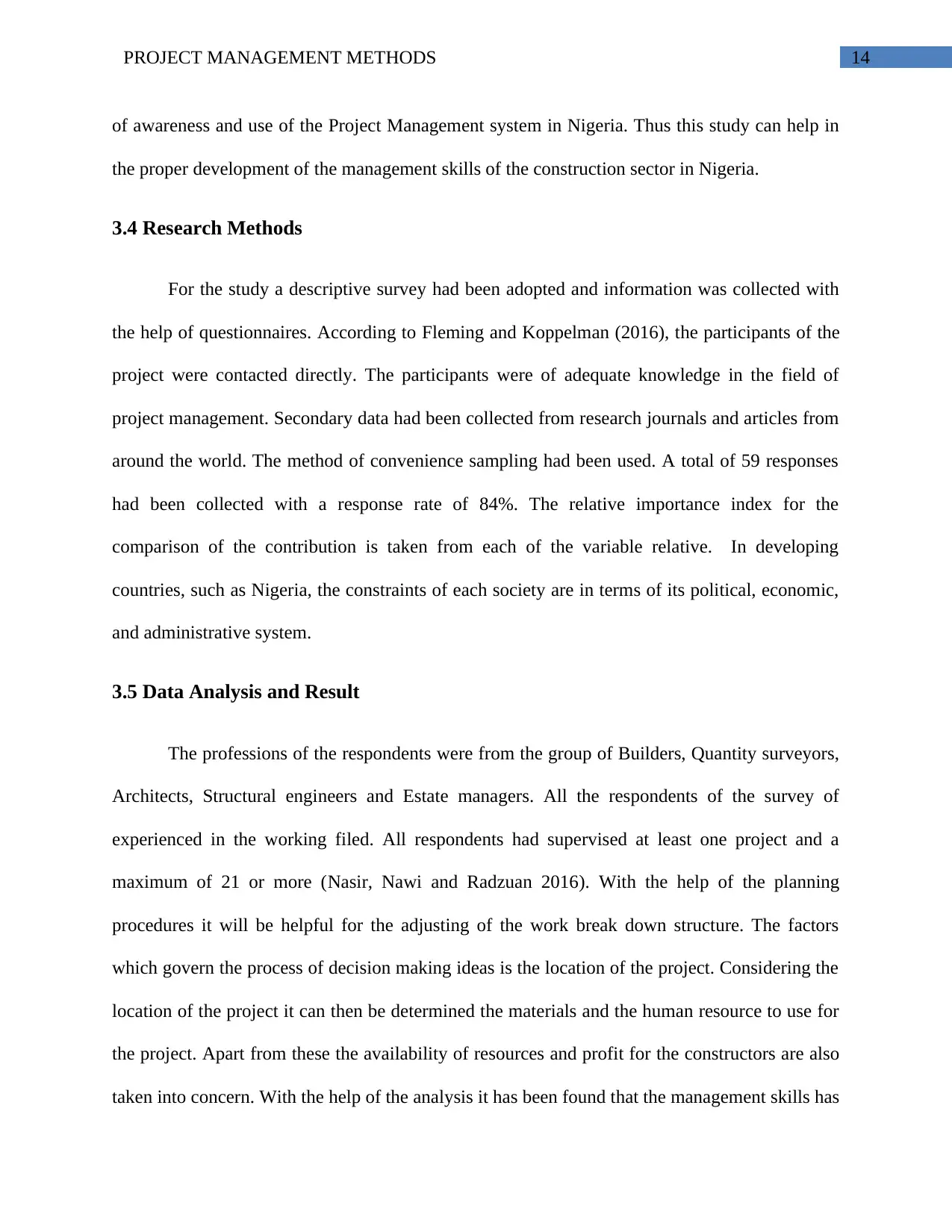
14PROJECT MANAGEMENT METHODS
of awareness and use of the Project Management system in Nigeria. Thus this study can help in
the proper development of the management skills of the construction sector in Nigeria.
3.4 Research Methods
For the study a descriptive survey had been adopted and information was collected with
the help of questionnaires. According to Fleming and Koppelman (2016), the participants of the
project were contacted directly. The participants were of adequate knowledge in the field of
project management. Secondary data had been collected from research journals and articles from
around the world. The method of convenience sampling had been used. A total of 59 responses
had been collected with a response rate of 84%. The relative importance index for the
comparison of the contribution is taken from each of the variable relative. In developing
countries, such as Nigeria, the constraints of each society are in terms of its political, economic,
and administrative system.
3.5 Data Analysis and Result
The professions of the respondents were from the group of Builders, Quantity surveyors,
Architects, Structural engineers and Estate managers. All the respondents of the survey of
experienced in the working filed. All respondents had supervised at least one project and a
maximum of 21 or more (Nasir, Nawi and Radzuan 2016). With the help of the planning
procedures it will be helpful for the adjusting of the work break down structure. The factors
which govern the process of decision making ideas is the location of the project. Considering the
location of the project it can then be determined the materials and the human resource to use for
the project. Apart from these the availability of resources and profit for the constructors are also
taken into concern. With the help of the analysis it has been found that the management skills has
of awareness and use of the Project Management system in Nigeria. Thus this study can help in
the proper development of the management skills of the construction sector in Nigeria.
3.4 Research Methods
For the study a descriptive survey had been adopted and information was collected with
the help of questionnaires. According to Fleming and Koppelman (2016), the participants of the
project were contacted directly. The participants were of adequate knowledge in the field of
project management. Secondary data had been collected from research journals and articles from
around the world. The method of convenience sampling had been used. A total of 59 responses
had been collected with a response rate of 84%. The relative importance index for the
comparison of the contribution is taken from each of the variable relative. In developing
countries, such as Nigeria, the constraints of each society are in terms of its political, economic,
and administrative system.
3.5 Data Analysis and Result
The professions of the respondents were from the group of Builders, Quantity surveyors,
Architects, Structural engineers and Estate managers. All the respondents of the survey of
experienced in the working filed. All respondents had supervised at least one project and a
maximum of 21 or more (Nasir, Nawi and Radzuan 2016). With the help of the planning
procedures it will be helpful for the adjusting of the work break down structure. The factors
which govern the process of decision making ideas is the location of the project. Considering the
location of the project it can then be determined the materials and the human resource to use for
the project. Apart from these the availability of resources and profit for the constructors are also
taken into concern. With the help of the analysis it has been found that the management skills has
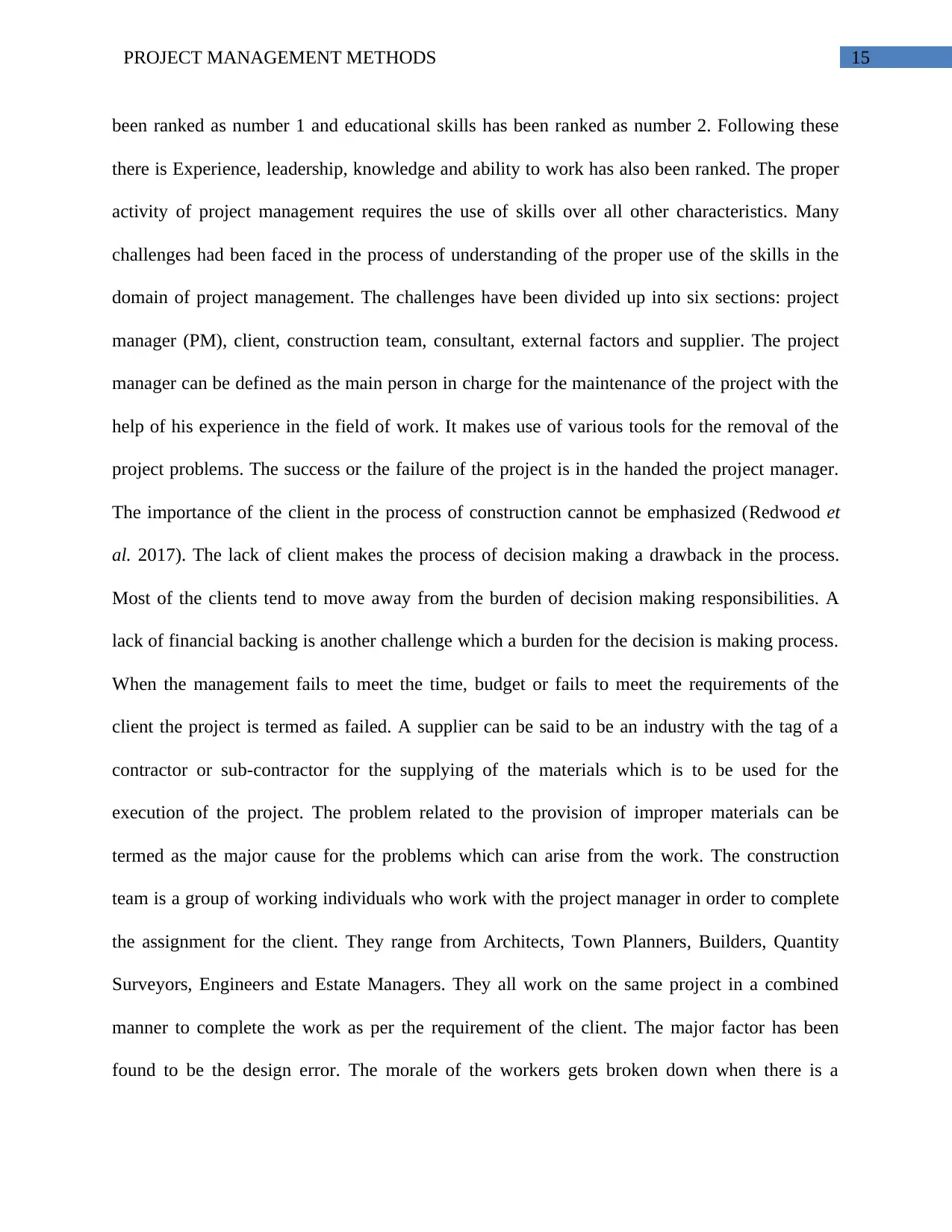
15PROJECT MANAGEMENT METHODS
been ranked as number 1 and educational skills has been ranked as number 2. Following these
there is Experience, leadership, knowledge and ability to work has also been ranked. The proper
activity of project management requires the use of skills over all other characteristics. Many
challenges had been faced in the process of understanding of the proper use of the skills in the
domain of project management. The challenges have been divided up into six sections: project
manager (PM), client, construction team, consultant, external factors and supplier. The project
manager can be defined as the main person in charge for the maintenance of the project with the
help of his experience in the field of work. It makes use of various tools for the removal of the
project problems. The success or the failure of the project is in the handed the project manager.
The importance of the client in the process of construction cannot be emphasized (Redwood et
al. 2017). The lack of client makes the process of decision making a drawback in the process.
Most of the clients tend to move away from the burden of decision making responsibilities. A
lack of financial backing is another challenge which a burden for the decision is making process.
When the management fails to meet the time, budget or fails to meet the requirements of the
client the project is termed as failed. A supplier can be said to be an industry with the tag of a
contractor or sub-contractor for the supplying of the materials which is to be used for the
execution of the project. The problem related to the provision of improper materials can be
termed as the major cause for the problems which can arise from the work. The construction
team is a group of working individuals who work with the project manager in order to complete
the assignment for the client. They range from Architects, Town Planners, Builders, Quantity
Surveyors, Engineers and Estate Managers. They all work on the same project in a combined
manner to complete the work as per the requirement of the client. The major factor has been
found to be the design error. The morale of the workers gets broken down when there is a
been ranked as number 1 and educational skills has been ranked as number 2. Following these
there is Experience, leadership, knowledge and ability to work has also been ranked. The proper
activity of project management requires the use of skills over all other characteristics. Many
challenges had been faced in the process of understanding of the proper use of the skills in the
domain of project management. The challenges have been divided up into six sections: project
manager (PM), client, construction team, consultant, external factors and supplier. The project
manager can be defined as the main person in charge for the maintenance of the project with the
help of his experience in the field of work. It makes use of various tools for the removal of the
project problems. The success or the failure of the project is in the handed the project manager.
The importance of the client in the process of construction cannot be emphasized (Redwood et
al. 2017). The lack of client makes the process of decision making a drawback in the process.
Most of the clients tend to move away from the burden of decision making responsibilities. A
lack of financial backing is another challenge which a burden for the decision is making process.
When the management fails to meet the time, budget or fails to meet the requirements of the
client the project is termed as failed. A supplier can be said to be an industry with the tag of a
contractor or sub-contractor for the supplying of the materials which is to be used for the
execution of the project. The problem related to the provision of improper materials can be
termed as the major cause for the problems which can arise from the work. The construction
team is a group of working individuals who work with the project manager in order to complete
the assignment for the client. They range from Architects, Town Planners, Builders, Quantity
Surveyors, Engineers and Estate Managers. They all work on the same project in a combined
manner to complete the work as per the requirement of the client. The major factor has been
found to be the design error. The morale of the workers gets broken down when there is a
Paraphrase This Document
Need a fresh take? Get an instant paraphrase of this document with our AI Paraphraser
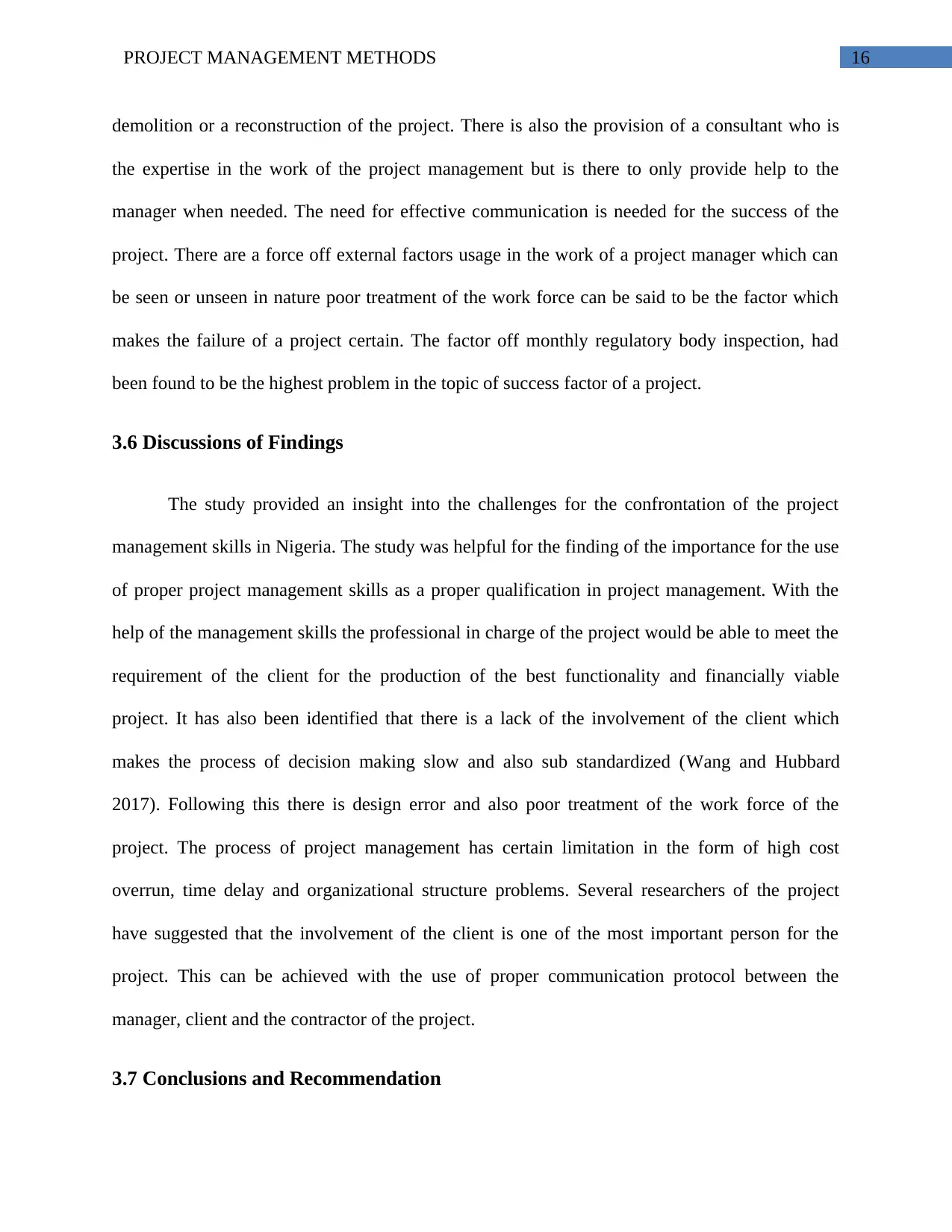
16PROJECT MANAGEMENT METHODS
demolition or a reconstruction of the project. There is also the provision of a consultant who is
the expertise in the work of the project management but is there to only provide help to the
manager when needed. The need for effective communication is needed for the success of the
project. There are a force off external factors usage in the work of a project manager which can
be seen or unseen in nature poor treatment of the work force can be said to be the factor which
makes the failure of a project certain. The factor off monthly regulatory body inspection, had
been found to be the highest problem in the topic of success factor of a project.
3.6 Discussions of Findings
The study provided an insight into the challenges for the confrontation of the project
management skills in Nigeria. The study was helpful for the finding of the importance for the use
of proper project management skills as a proper qualification in project management. With the
help of the management skills the professional in charge of the project would be able to meet the
requirement of the client for the production of the best functionality and financially viable
project. It has also been identified that there is a lack of the involvement of the client which
makes the process of decision making slow and also sub standardized (Wang and Hubbard
2017). Following this there is design error and also poor treatment of the work force of the
project. The process of project management has certain limitation in the form of high cost
overrun, time delay and organizational structure problems. Several researchers of the project
have suggested that the involvement of the client is one of the most important person for the
project. This can be achieved with the use of proper communication protocol between the
manager, client and the contractor of the project.
3.7 Conclusions and Recommendation
demolition or a reconstruction of the project. There is also the provision of a consultant who is
the expertise in the work of the project management but is there to only provide help to the
manager when needed. The need for effective communication is needed for the success of the
project. There are a force off external factors usage in the work of a project manager which can
be seen or unseen in nature poor treatment of the work force can be said to be the factor which
makes the failure of a project certain. The factor off monthly regulatory body inspection, had
been found to be the highest problem in the topic of success factor of a project.
3.6 Discussions of Findings
The study provided an insight into the challenges for the confrontation of the project
management skills in Nigeria. The study was helpful for the finding of the importance for the use
of proper project management skills as a proper qualification in project management. With the
help of the management skills the professional in charge of the project would be able to meet the
requirement of the client for the production of the best functionality and financially viable
project. It has also been identified that there is a lack of the involvement of the client which
makes the process of decision making slow and also sub standardized (Wang and Hubbard
2017). Following this there is design error and also poor treatment of the work force of the
project. The process of project management has certain limitation in the form of high cost
overrun, time delay and organizational structure problems. Several researchers of the project
have suggested that the involvement of the client is one of the most important person for the
project. This can be achieved with the use of proper communication protocol between the
manager, client and the contractor of the project.
3.7 Conclusions and Recommendation

17PROJECT MANAGEMENT METHODS
The study of the project has provided many strategies for the protection of profession
form imposters. The study has also suggested that there should be the use of an active project
management body for the regulation of rules and notification for the work of the managers
working with any project. It can be concluded that the factor that is used for the influence of
planning decision by the mangers is the location of the project.
It is to be recommended that there should be training and skills modification program for
the professionals who wants to work on projects. Training courses would be held on a yearly
basis to keep the work of the professionals clear from any degrading methods. The government
should also work toward the provision of standard improvement for the practice of the profession
of project management. There should be standards set forward for the implementation of the
penalization of ill practice of the work.
Conclusion
It can be concluded from the assignment that the project management had formed the
integration of the activities of project and deploys the management of the construction activities
and functions. The deployment of the construction project management had ensured that the
project had been constructed and completed successfully. The “Management of construction
materials on project site”, “Interfacing and complexity issues in construction project
management”, and “Challenges confronting construction project management system for
sustainable construction in developing countries” were used for forming the analysis of the
concept of the project management in construction projects. The analysis of the first article
developed for ensuring that the deployment of the effective management process has considered
the purpose and process of material management for construction projects with the help of a
The study of the project has provided many strategies for the protection of profession
form imposters. The study has also suggested that there should be the use of an active project
management body for the regulation of rules and notification for the work of the managers
working with any project. It can be concluded that the factor that is used for the influence of
planning decision by the mangers is the location of the project.
It is to be recommended that there should be training and skills modification program for
the professionals who wants to work on projects. Training courses would be held on a yearly
basis to keep the work of the professionals clear from any degrading methods. The government
should also work toward the provision of standard improvement for the practice of the profession
of project management. There should be standards set forward for the implementation of the
penalization of ill practice of the work.
Conclusion
It can be concluded from the assignment that the project management had formed the
integration of the activities of project and deploys the management of the construction activities
and functions. The deployment of the construction project management had ensured that the
project had been constructed and completed successfully. The “Management of construction
materials on project site”, “Interfacing and complexity issues in construction project
management”, and “Challenges confronting construction project management system for
sustainable construction in developing countries” were used for forming the analysis of the
concept of the project management in construction projects. The analysis of the first article
developed for ensuring that the deployment of the effective management process has considered
the purpose and process of material management for construction projects with the help of a
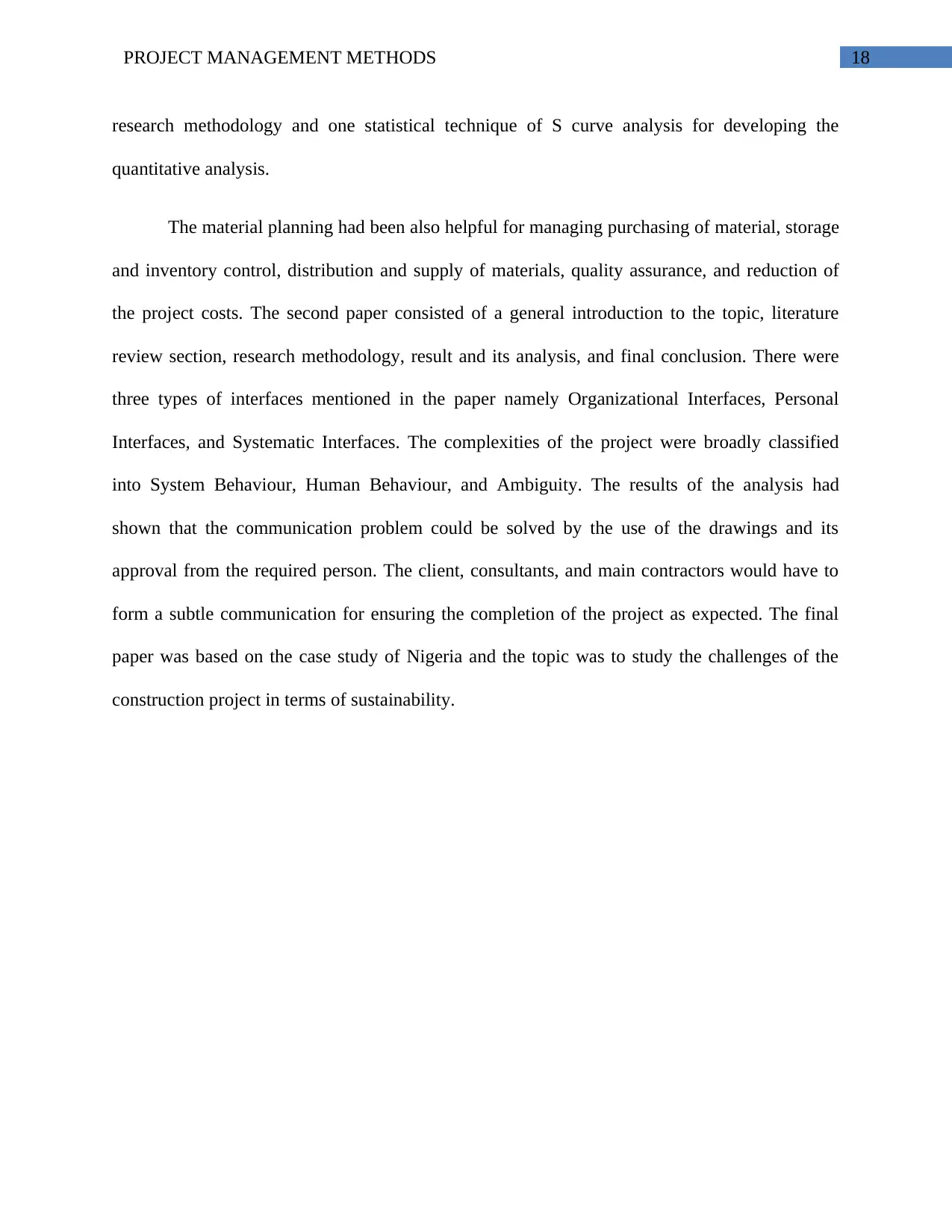
18PROJECT MANAGEMENT METHODS
research methodology and one statistical technique of S curve analysis for developing the
quantitative analysis.
The material planning had been also helpful for managing purchasing of material, storage
and inventory control, distribution and supply of materials, quality assurance, and reduction of
the project costs. The second paper consisted of a general introduction to the topic, literature
review section, research methodology, result and its analysis, and final conclusion. There were
three types of interfaces mentioned in the paper namely Organizational Interfaces, Personal
Interfaces, and Systematic Interfaces. The complexities of the project were broadly classified
into System Behaviour, Human Behaviour, and Ambiguity. The results of the analysis had
shown that the communication problem could be solved by the use of the drawings and its
approval from the required person. The client, consultants, and main contractors would have to
form a subtle communication for ensuring the completion of the project as expected. The final
paper was based on the case study of Nigeria and the topic was to study the challenges of the
construction project in terms of sustainability.
research methodology and one statistical technique of S curve analysis for developing the
quantitative analysis.
The material planning had been also helpful for managing purchasing of material, storage
and inventory control, distribution and supply of materials, quality assurance, and reduction of
the project costs. The second paper consisted of a general introduction to the topic, literature
review section, research methodology, result and its analysis, and final conclusion. There were
three types of interfaces mentioned in the paper namely Organizational Interfaces, Personal
Interfaces, and Systematic Interfaces. The complexities of the project were broadly classified
into System Behaviour, Human Behaviour, and Ambiguity. The results of the analysis had
shown that the communication problem could be solved by the use of the drawings and its
approval from the required person. The client, consultants, and main contractors would have to
form a subtle communication for ensuring the completion of the project as expected. The final
paper was based on the case study of Nigeria and the topic was to study the challenges of the
construction project in terms of sustainability.
Secure Best Marks with AI Grader
Need help grading? Try our AI Grader for instant feedback on your assignments.
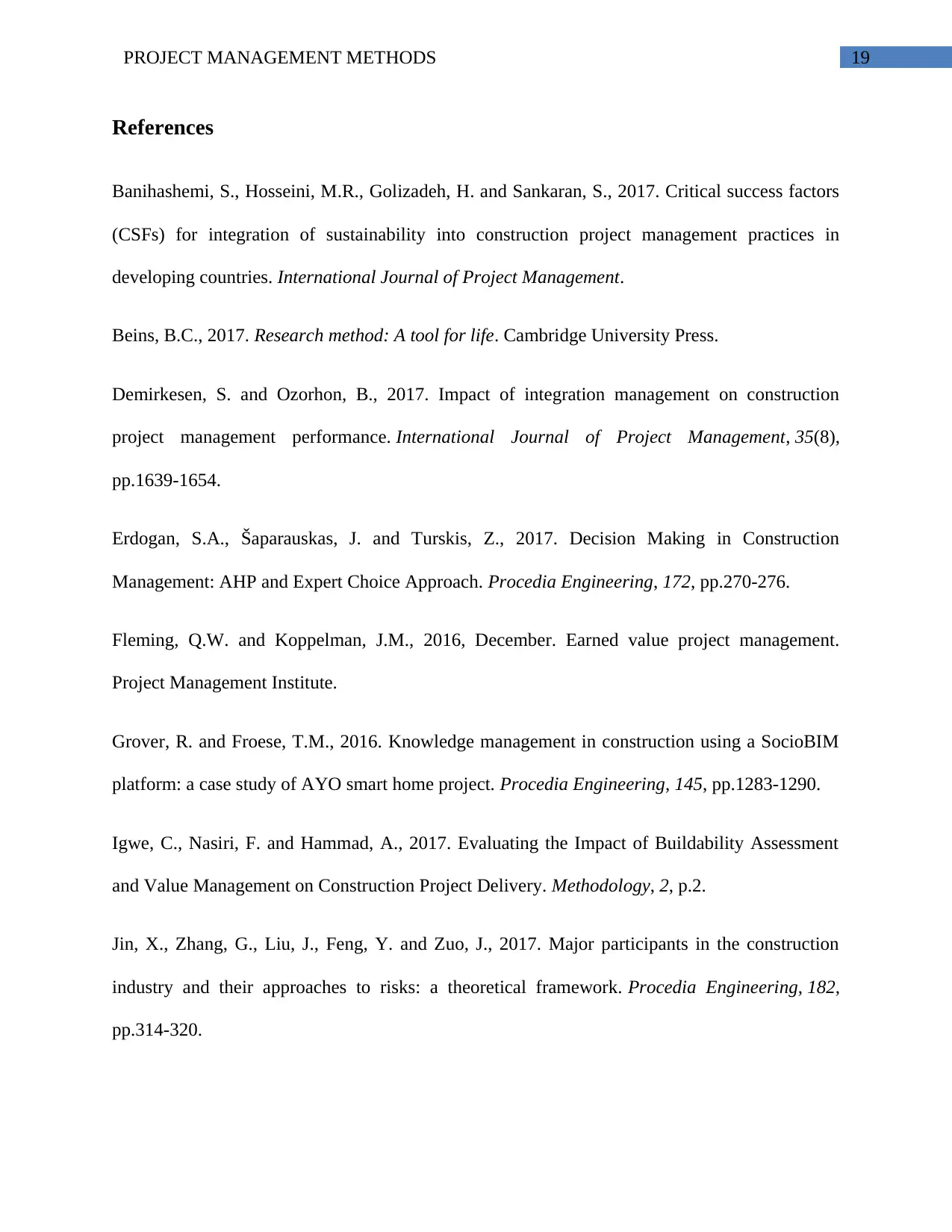
19PROJECT MANAGEMENT METHODS
References
Banihashemi, S., Hosseini, M.R., Golizadeh, H. and Sankaran, S., 2017. Critical success factors
(CSFs) for integration of sustainability into construction project management practices in
developing countries. International Journal of Project Management.
Beins, B.C., 2017. Research method: A tool for life. Cambridge University Press.
Demirkesen, S. and Ozorhon, B., 2017. Impact of integration management on construction
project management performance. International Journal of Project Management, 35(8),
pp.1639-1654.
Erdogan, S.A., Šaparauskas, J. and Turskis, Z., 2017. Decision Making in Construction
Management: AHP and Expert Choice Approach. Procedia Engineering, 172, pp.270-276.
Fleming, Q.W. and Koppelman, J.M., 2016, December. Earned value project management.
Project Management Institute.
Grover, R. and Froese, T.M., 2016. Knowledge management in construction using a SocioBIM
platform: a case study of AYO smart home project. Procedia Engineering, 145, pp.1283-1290.
Igwe, C., Nasiri, F. and Hammad, A., 2017. Evaluating the Impact of Buildability Assessment
and Value Management on Construction Project Delivery. Methodology, 2, p.2.
Jin, X., Zhang, G., Liu, J., Feng, Y. and Zuo, J., 2017. Major participants in the construction
industry and their approaches to risks: a theoretical framework. Procedia Engineering, 182,
pp.314-320.
References
Banihashemi, S., Hosseini, M.R., Golizadeh, H. and Sankaran, S., 2017. Critical success factors
(CSFs) for integration of sustainability into construction project management practices in
developing countries. International Journal of Project Management.
Beins, B.C., 2017. Research method: A tool for life. Cambridge University Press.
Demirkesen, S. and Ozorhon, B., 2017. Impact of integration management on construction
project management performance. International Journal of Project Management, 35(8),
pp.1639-1654.
Erdogan, S.A., Šaparauskas, J. and Turskis, Z., 2017. Decision Making in Construction
Management: AHP and Expert Choice Approach. Procedia Engineering, 172, pp.270-276.
Fleming, Q.W. and Koppelman, J.M., 2016, December. Earned value project management.
Project Management Institute.
Grover, R. and Froese, T.M., 2016. Knowledge management in construction using a SocioBIM
platform: a case study of AYO smart home project. Procedia Engineering, 145, pp.1283-1290.
Igwe, C., Nasiri, F. and Hammad, A., 2017. Evaluating the Impact of Buildability Assessment
and Value Management on Construction Project Delivery. Methodology, 2, p.2.
Jin, X., Zhang, G., Liu, J., Feng, Y. and Zuo, J., 2017. Major participants in the construction
industry and their approaches to risks: a theoretical framework. Procedia Engineering, 182,
pp.314-320.
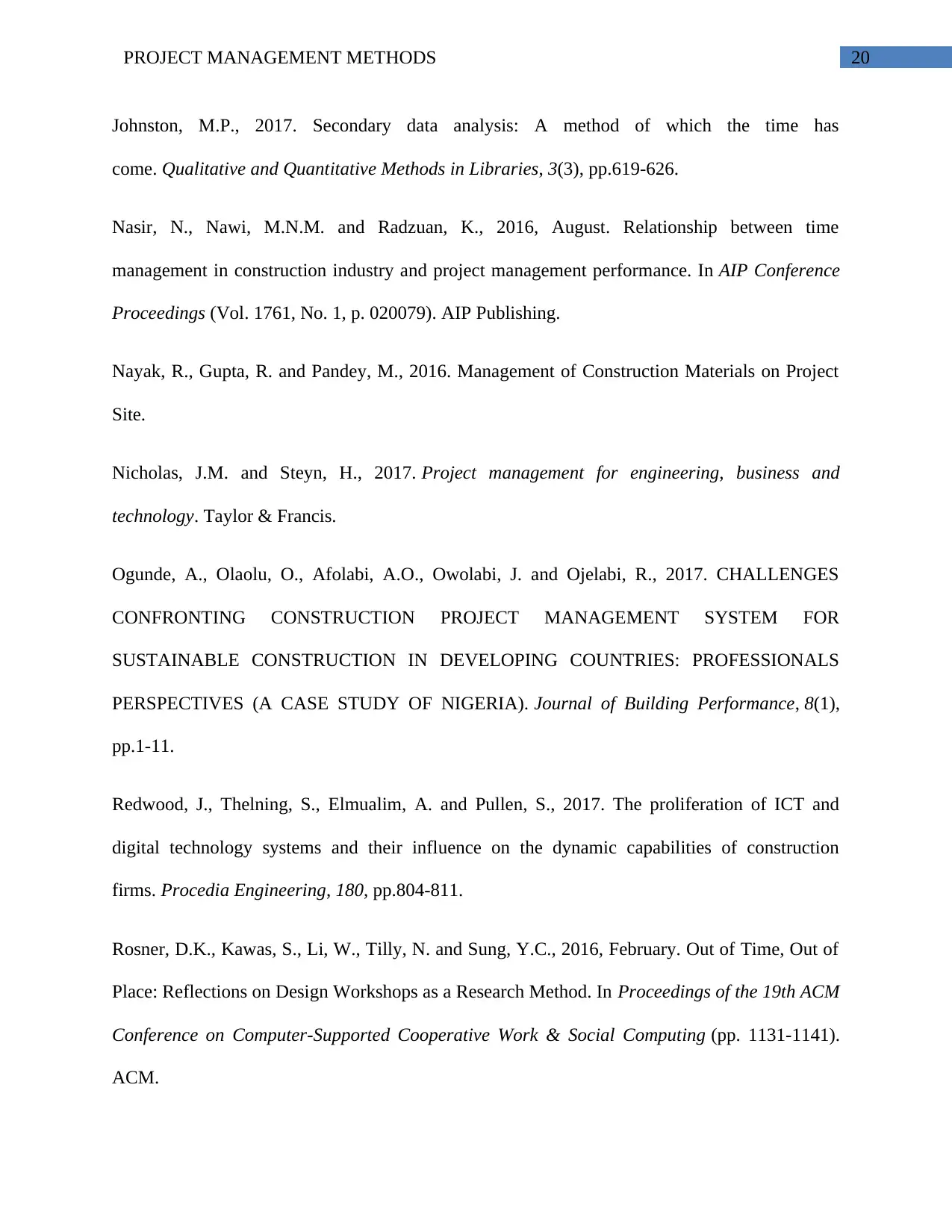
20PROJECT MANAGEMENT METHODS
Johnston, M.P., 2017. Secondary data analysis: A method of which the time has
come. Qualitative and Quantitative Methods in Libraries, 3(3), pp.619-626.
Nasir, N., Nawi, M.N.M. and Radzuan, K., 2016, August. Relationship between time
management in construction industry and project management performance. In AIP Conference
Proceedings (Vol. 1761, No. 1, p. 020079). AIP Publishing.
Nayak, R., Gupta, R. and Pandey, M., 2016. Management of Construction Materials on Project
Site.
Nicholas, J.M. and Steyn, H., 2017. Project management for engineering, business and
technology. Taylor & Francis.
Ogunde, A., Olaolu, O., Afolabi, A.O., Owolabi, J. and Ojelabi, R., 2017. CHALLENGES
CONFRONTING CONSTRUCTION PROJECT MANAGEMENT SYSTEM FOR
SUSTAINABLE CONSTRUCTION IN DEVELOPING COUNTRIES: PROFESSIONALS
PERSPECTIVES (A CASE STUDY OF NIGERIA). Journal of Building Performance, 8(1),
pp.1-11.
Redwood, J., Thelning, S., Elmualim, A. and Pullen, S., 2017. The proliferation of ICT and
digital technology systems and their influence on the dynamic capabilities of construction
firms. Procedia Engineering, 180, pp.804-811.
Rosner, D.K., Kawas, S., Li, W., Tilly, N. and Sung, Y.C., 2016, February. Out of Time, Out of
Place: Reflections on Design Workshops as a Research Method. In Proceedings of the 19th ACM
Conference on Computer-Supported Cooperative Work & Social Computing (pp. 1131-1141).
ACM.
Johnston, M.P., 2017. Secondary data analysis: A method of which the time has
come. Qualitative and Quantitative Methods in Libraries, 3(3), pp.619-626.
Nasir, N., Nawi, M.N.M. and Radzuan, K., 2016, August. Relationship between time
management in construction industry and project management performance. In AIP Conference
Proceedings (Vol. 1761, No. 1, p. 020079). AIP Publishing.
Nayak, R., Gupta, R. and Pandey, M., 2016. Management of Construction Materials on Project
Site.
Nicholas, J.M. and Steyn, H., 2017. Project management for engineering, business and
technology. Taylor & Francis.
Ogunde, A., Olaolu, O., Afolabi, A.O., Owolabi, J. and Ojelabi, R., 2017. CHALLENGES
CONFRONTING CONSTRUCTION PROJECT MANAGEMENT SYSTEM FOR
SUSTAINABLE CONSTRUCTION IN DEVELOPING COUNTRIES: PROFESSIONALS
PERSPECTIVES (A CASE STUDY OF NIGERIA). Journal of Building Performance, 8(1),
pp.1-11.
Redwood, J., Thelning, S., Elmualim, A. and Pullen, S., 2017. The proliferation of ICT and
digital technology systems and their influence on the dynamic capabilities of construction
firms. Procedia Engineering, 180, pp.804-811.
Rosner, D.K., Kawas, S., Li, W., Tilly, N. and Sung, Y.C., 2016, February. Out of Time, Out of
Place: Reflections on Design Workshops as a Research Method. In Proceedings of the 19th ACM
Conference on Computer-Supported Cooperative Work & Social Computing (pp. 1131-1141).
ACM.
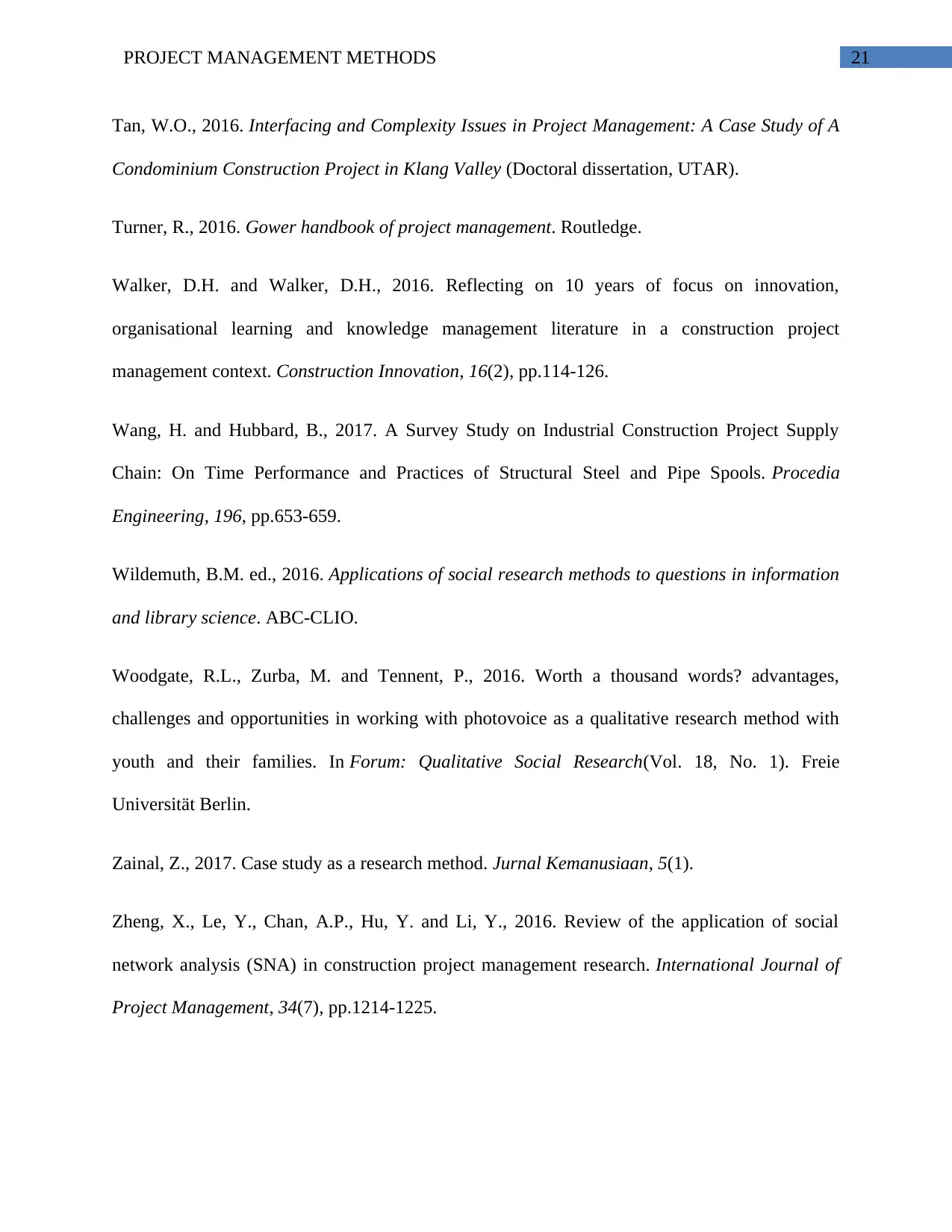
21PROJECT MANAGEMENT METHODS
Tan, W.O., 2016. Interfacing and Complexity Issues in Project Management: A Case Study of A
Condominium Construction Project in Klang Valley (Doctoral dissertation, UTAR).
Turner, R., 2016. Gower handbook of project management. Routledge.
Walker, D.H. and Walker, D.H., 2016. Reflecting on 10 years of focus on innovation,
organisational learning and knowledge management literature in a construction project
management context. Construction Innovation, 16(2), pp.114-126.
Wang, H. and Hubbard, B., 2017. A Survey Study on Industrial Construction Project Supply
Chain: On Time Performance and Practices of Structural Steel and Pipe Spools. Procedia
Engineering, 196, pp.653-659.
Wildemuth, B.M. ed., 2016. Applications of social research methods to questions in information
and library science. ABC-CLIO.
Woodgate, R.L., Zurba, M. and Tennent, P., 2016. Worth a thousand words? advantages,
challenges and opportunities in working with photovoice as a qualitative research method with
youth and their families. In Forum: Qualitative Social Research(Vol. 18, No. 1). Freie
Universität Berlin.
Zainal, Z., 2017. Case study as a research method. Jurnal Kemanusiaan, 5(1).
Zheng, X., Le, Y., Chan, A.P., Hu, Y. and Li, Y., 2016. Review of the application of social
network analysis (SNA) in construction project management research. International Journal of
Project Management, 34(7), pp.1214-1225.
Tan, W.O., 2016. Interfacing and Complexity Issues in Project Management: A Case Study of A
Condominium Construction Project in Klang Valley (Doctoral dissertation, UTAR).
Turner, R., 2016. Gower handbook of project management. Routledge.
Walker, D.H. and Walker, D.H., 2016. Reflecting on 10 years of focus on innovation,
organisational learning and knowledge management literature in a construction project
management context. Construction Innovation, 16(2), pp.114-126.
Wang, H. and Hubbard, B., 2017. A Survey Study on Industrial Construction Project Supply
Chain: On Time Performance and Practices of Structural Steel and Pipe Spools. Procedia
Engineering, 196, pp.653-659.
Wildemuth, B.M. ed., 2016. Applications of social research methods to questions in information
and library science. ABC-CLIO.
Woodgate, R.L., Zurba, M. and Tennent, P., 2016. Worth a thousand words? advantages,
challenges and opportunities in working with photovoice as a qualitative research method with
youth and their families. In Forum: Qualitative Social Research(Vol. 18, No. 1). Freie
Universität Berlin.
Zainal, Z., 2017. Case study as a research method. Jurnal Kemanusiaan, 5(1).
Zheng, X., Le, Y., Chan, A.P., Hu, Y. and Li, Y., 2016. Review of the application of social
network analysis (SNA) in construction project management research. International Journal of
Project Management, 34(7), pp.1214-1225.
1 out of 22
![[object Object]](/_next/static/media/star-bottom.7253800d.svg)





